September 1, 2021 – We visit Podravina to discover the incredible Hlebine School of Croatian Naive Art
Croatia is sometimes difficult to find. Of course, with modern GPS and Croatia's nine international airports, getting here is no problem. But just where are you when you arrive?
Looking down at your dinner, the plate may hold a dish recognisable across the Mediterranean. Above your head, the architecture could be Roman, Austro-Hungarian or modern, indistinguishable. Ottoman influence lies everywhere from the best-loved handheld snacks to the mountain of slippers in every dwelling's doorway.
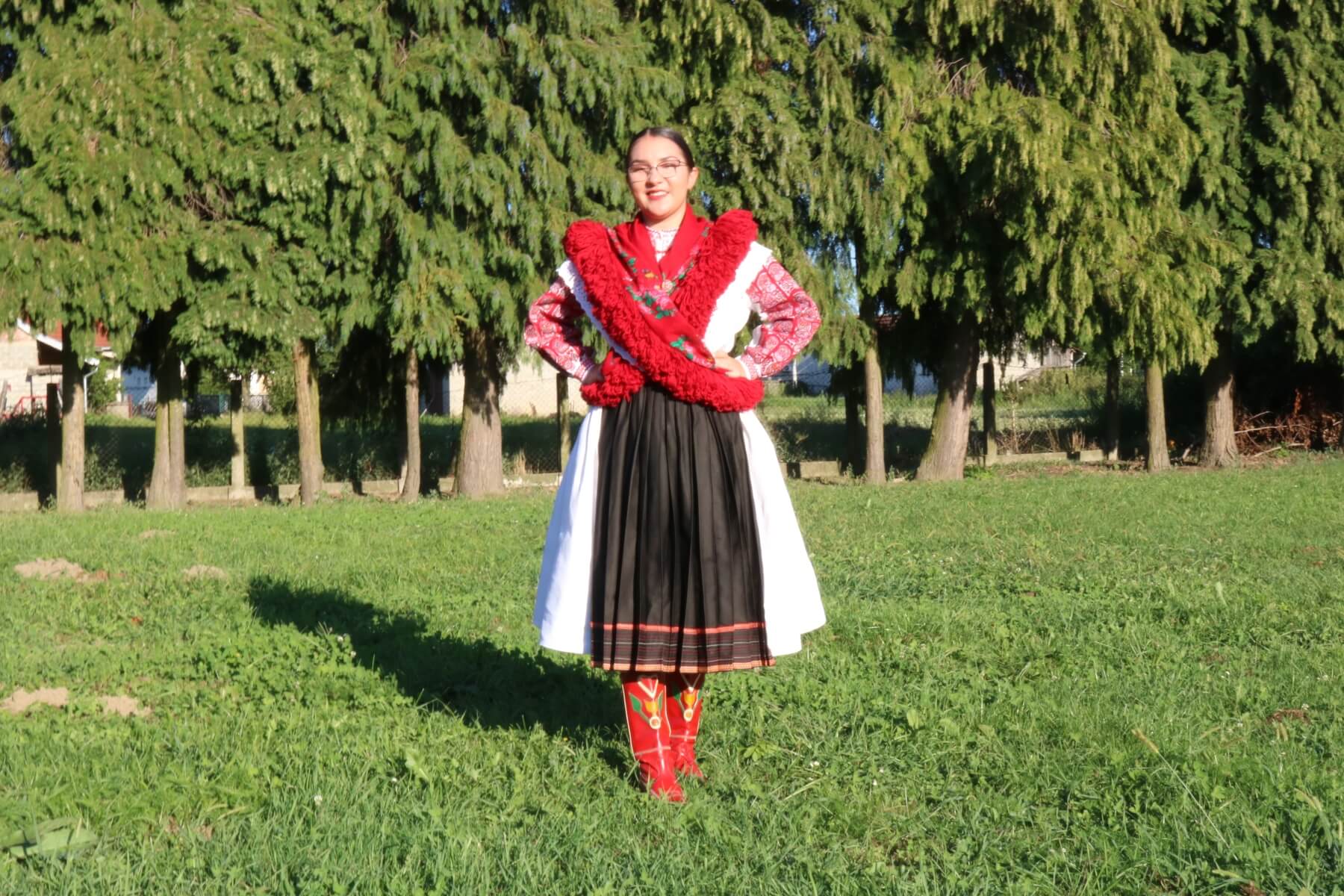 A friendly local wears the folk costume of the small region surrounding Koprivnički Ivanec, near Koprivnica. The costume features the incredibly intricate Ivanečki vez embroidery, which has been safeguarded locally for over 90 years and is now a protected part of Croatia's cultural heritage. Photo © Marc Rowlands.
A friendly local wears the folk costume of the small region surrounding Koprivnički Ivanec, near Koprivnica. The costume features the incredibly intricate Ivanečki vez embroidery, which has been safeguarded locally for over 90 years and is now a protected part of Croatia's cultural heritage. Photo © Marc Rowlands.
Actually, the true essence of the country you'll find in the Croatians themselves. And yet, their history is all too often obscured by the impositions of empires that once were here. However, we can find this history away from the major cities, the centres of influence. We find it in the villages. Specifically, in their folk costume, their folk song and folk dance. And we find it in the art there.
What is Naive Art?
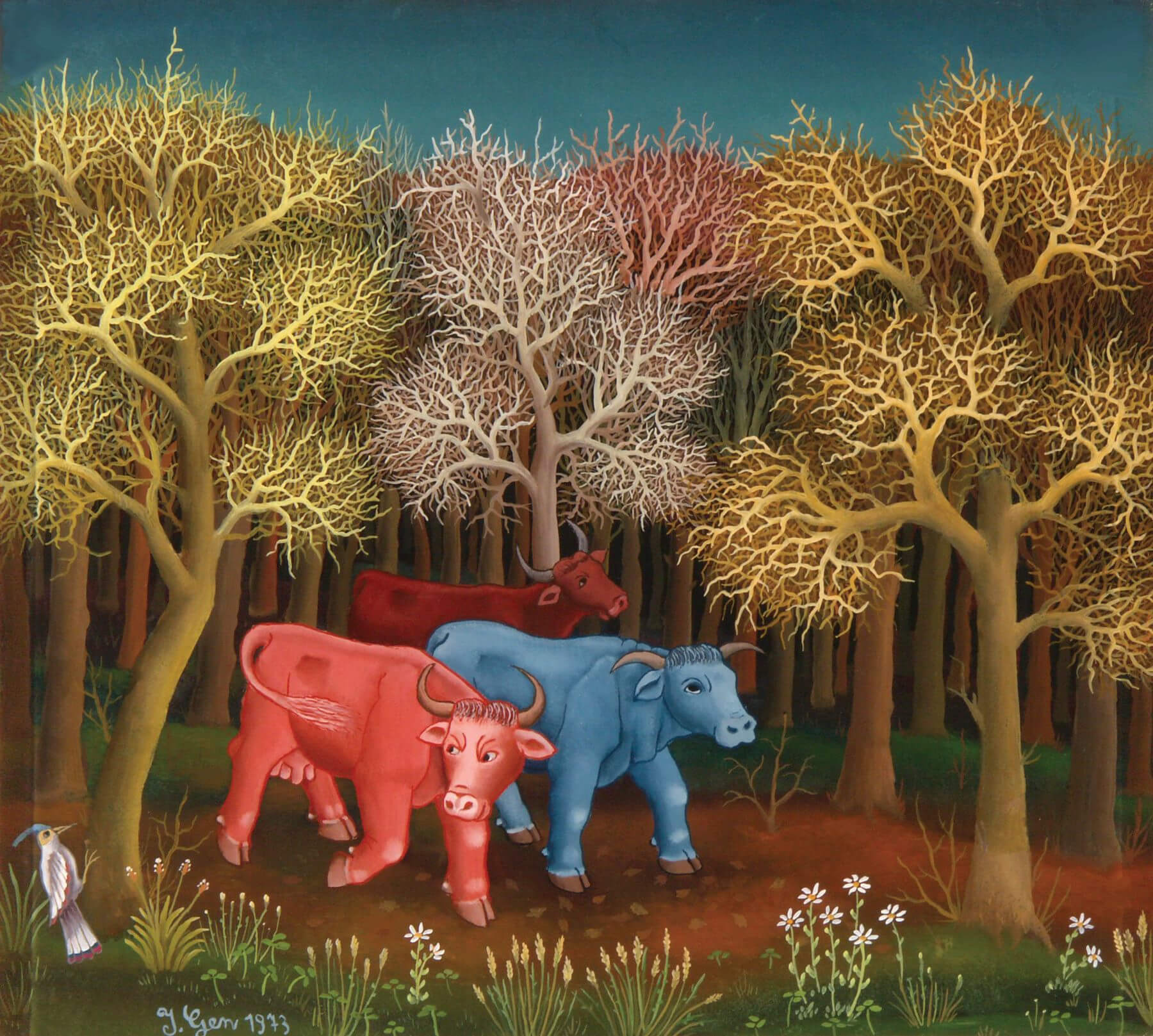 Cows In The Woods by Ivan Generalić, hanging at the Galerija naivne umjetnosti (Gallery of Naive Art), Hlebine © Koprivnica Town Museum
Cows In The Woods by Ivan Generalić, hanging at the Galerija naivne umjetnosti (Gallery of Naive Art), Hlebine © Koprivnica Town Museum
Naive art is any art made by someone who has received no formal or classical training. In this sense, the earliest discovered art of humans – cave paintings – are naïve art. However, there is nothing the classical art world likes more than specifically defining art movements. And, to them, the modern era of European Naive Art begins in the late 19th Century, with a growing appreciation of painters like French Post-Impressionist Henri Rousseau (1844–1910).
Because of the lack of formal, classical or academic training, it is said that common characteristics exist within the work of many Naive Artists. Specifically, these characteristics stem from an ignorance of strict perspective. Naive Artists often do not mute colours or lessen detail with distance. Also, they often don't attempt to accurately decrease the size of objects at distance.
Croatian culture as a part of national identity
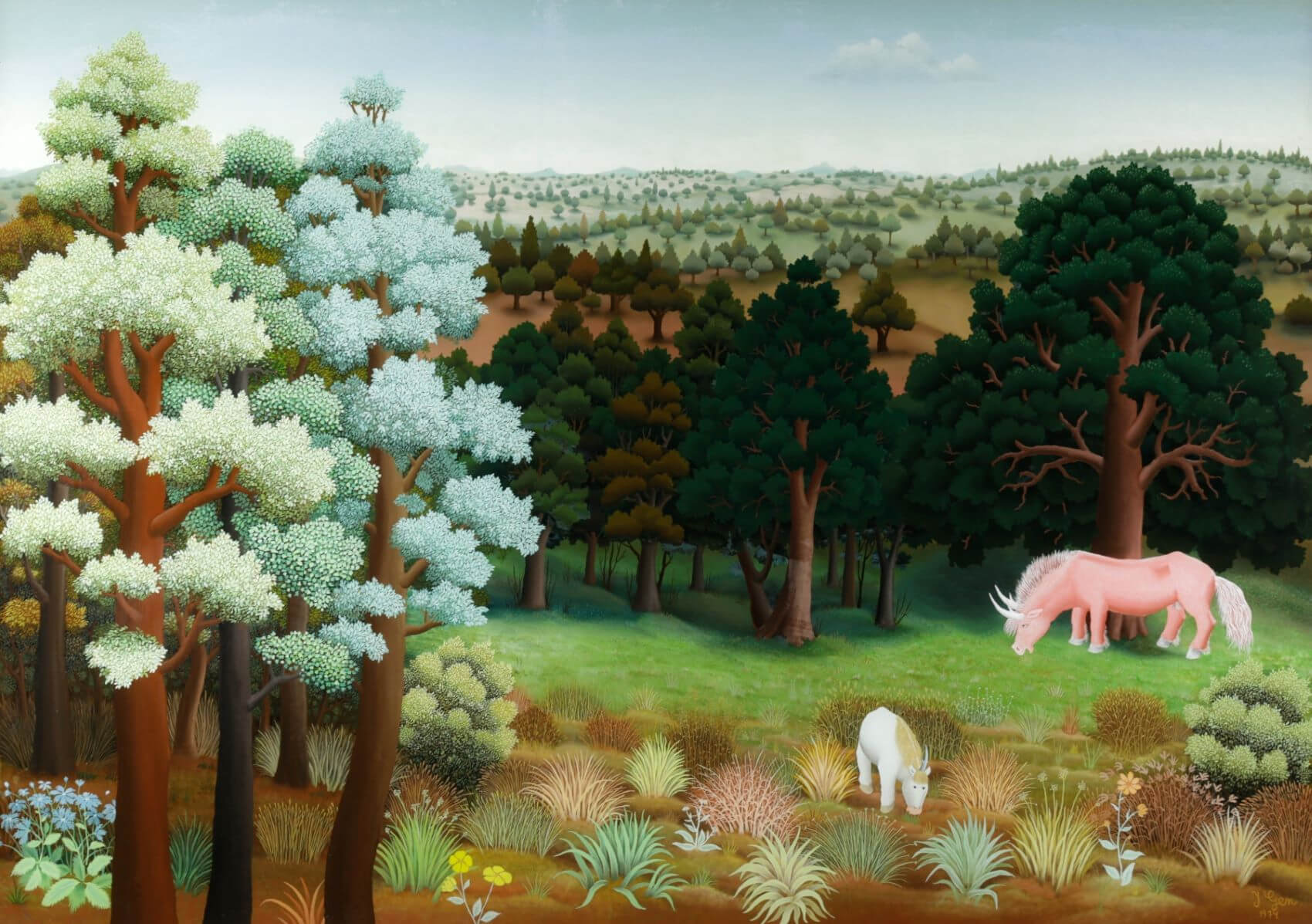 Horned horse by Ivan Generalić, hanging at the Galerija naivne umjetnosti (Gallery of Naive Art), Hlebine © Koprivnica Town Museum
Horned horse by Ivan Generalić, hanging at the Galerija naivne umjetnosti (Gallery of Naive Art), Hlebine © Koprivnica Town Museum
Croatian Naive Art is one of the best recognised and best-loved in the world. In truth, Croatia's movement doesn't begin to emerge until well into the 20th Century. Although, it is important to view the country's Naive Art within its broader search for a Croatian national identity. The roots of this movement stem back over 100 years prior to the emergence of Croatian Naive Art, beginning with the foundation of the Illyrian movement, Matica Hrvatska and more.
This older movement of national awakening had strong preoccupations with language, written text and cultural identity. Actually, its instigators were very much the educated intelligentsia of cities like Zagreb.
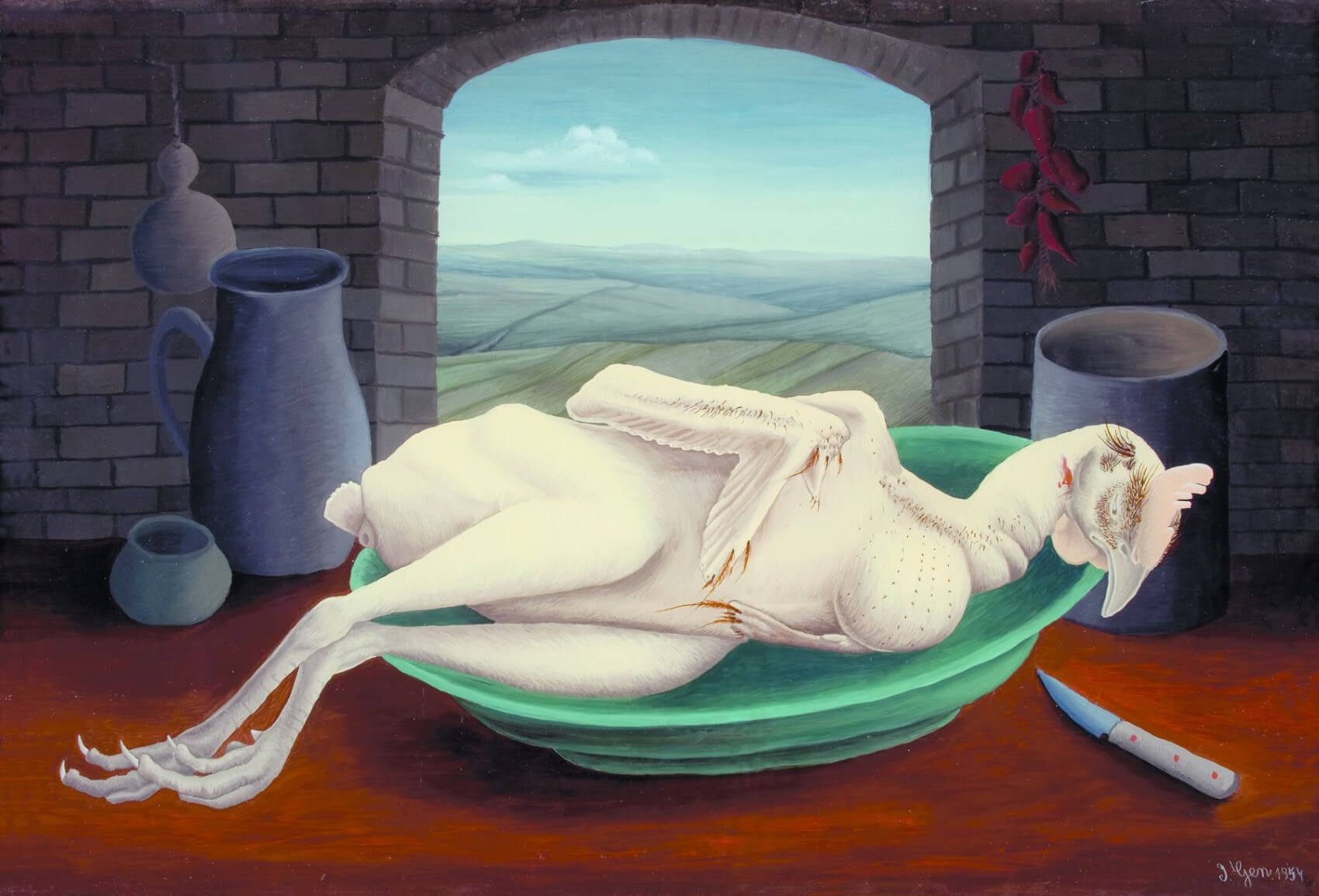 'A Battered Rooster' by Ivan Generalić, hanging at the Galerija naivne umjetnosti (Gallery of Naive Art), Hlebine © Koprivnica Town Museum
'A Battered Rooster' by Ivan Generalić, hanging at the Galerija naivne umjetnosti (Gallery of Naive Art), Hlebine © Koprivnica Town Museum
Before the end of World War I, Russia had undergone two revolutions. After the war, the German, Austro-Hungarian and Ottoman empires collapsed. Much of Europe was plunged into over half a decade of political upheaval - revolts, unrest and strikes by workers. Mostly socialist in sentiment - organised by workers and disillusioned former soldiers – this unrest and the accompanying birth of new nations lay not in the hands of the inner-city intelligentsia. And, many believed the cultural and artistic expression which reflected this new era should also come from the proletariat.
Krsto Hegedušić and the Earth Group (Grupa Zemlja)
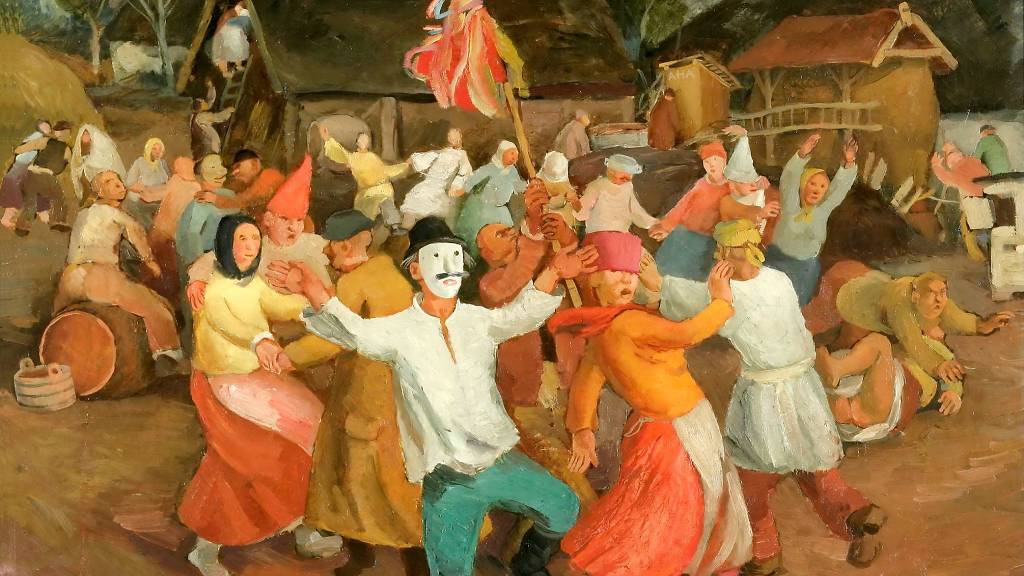 Krsto Hegedušić 'poklade' © Muzej moderne i suvremene umjetnosti Rijeka (MMSU)
Krsto Hegedušić 'poklade' © Muzej moderne i suvremene umjetnosti Rijeka (MMSU)
One Croat who believed strongly in this was painter Krsto Hegedušić. He co-founded the Earth Group in 1929 during a challenging period for Croatia. Europe was still reaping the dire economic repercussions of the First World War. Croatia had finally been freed of Austro-Hungarian hegemony, only to be forced into existing within another monarchy.
The founding beliefs of the Earth Group were that authentic artistic expression should be a product of the time and space whence it came and should be free of foreign influence. Art should not be created for the sake of art, but to depict an actual reality.
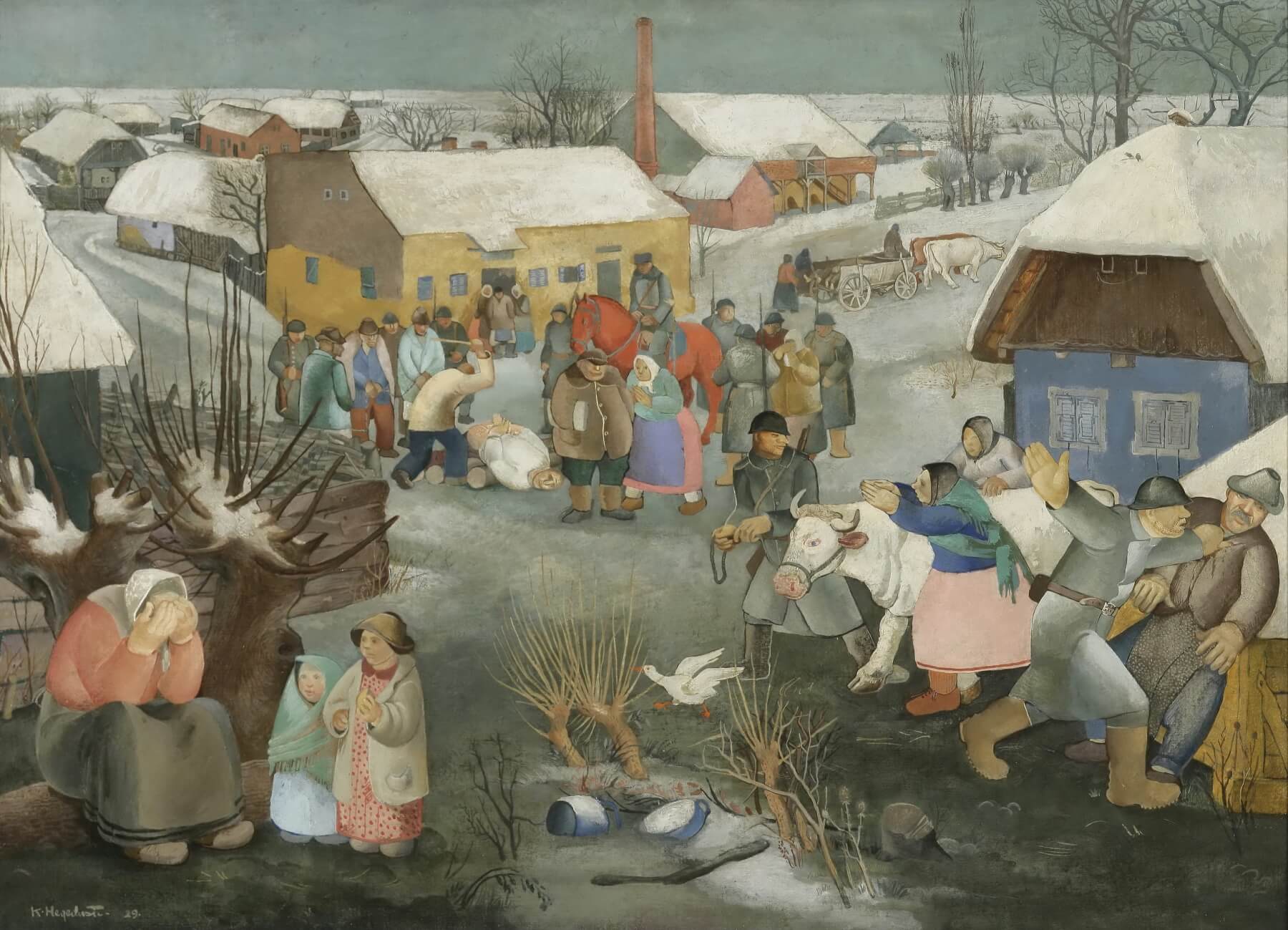 Krsto Hegedušić 'Rekvizicija (Requisition)', 1929 © Museum of Modern and Contemporary Art, Rijeka
Krsto Hegedušić 'Rekvizicija (Requisition)', 1929 © Museum of Modern and Contemporary Art, Rijeka
Krsto Hegedušić himself was very much a product of his studies. In 1920 he enrolled in what is today the Academy of Fine Arts in Zagreb. After graduating, he spent an additional two years on a scholarship in Paris. And yet, as a painter, his subject matter often reflected the world around him. Social critiques, within his work he depicted everyday poverty and the exploitation of Croatian peasants.
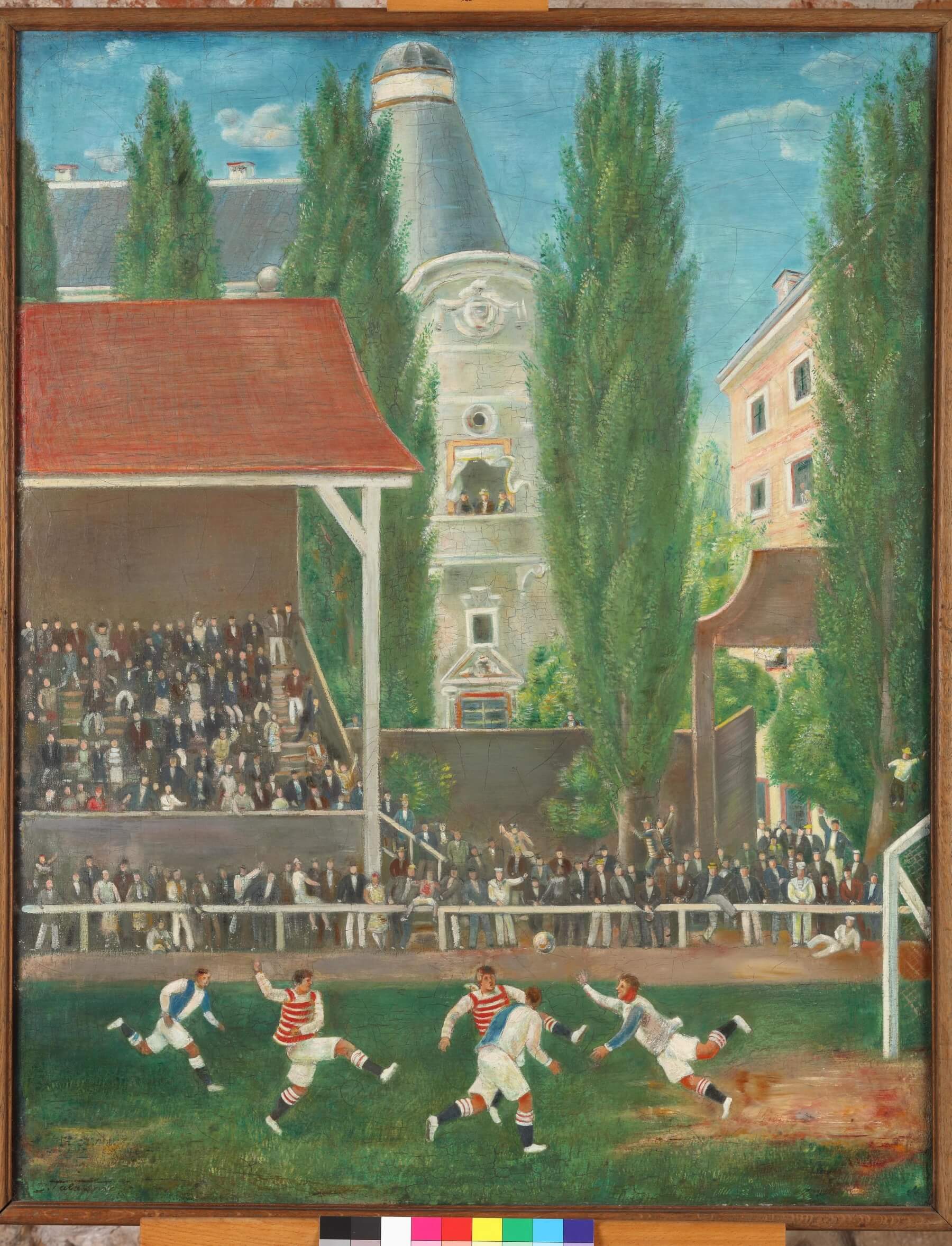 'Football match' by another of the Earth Group's founding members, Ivan Tabaković, 1927 © Gallery of Matica srpska, Novi Sad
'Football match' by another of the Earth Group's founding members, Ivan Tabaković, 1927 © Gallery of Matica srpska, Novi Sad
Born in Petrinja, Krsto Hegedušić spent summer holidays in the idyllic countryside and agricultural land surrounding his father's birth village of Hlebine, Podravina. When he was aged just 8 years old, Krsto's father died. Subsequently, the family moved to Hlebine. Later, Krsto would spend time living in Zagreb, not least for the duration of his studies. But, just one year into the life of the Earth Group, Krsto Hegedušić discovered a teenage artist back in Hlebine.
Hlebine School First Generation: Ivan Generalić, Franjo Mraz and Mirko Virius
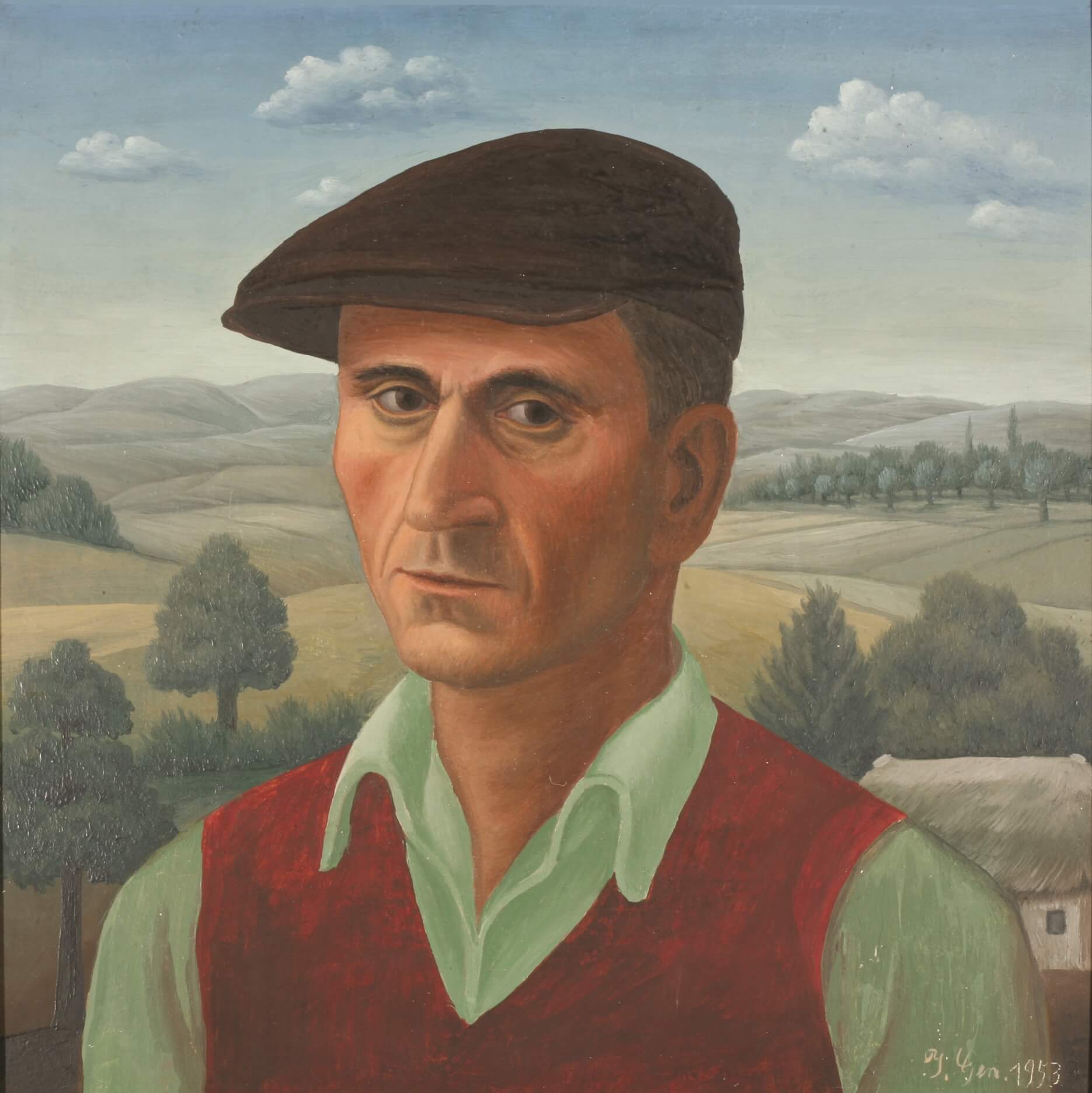 Self-portrait by Ivan Generalić, hanging at the Galerija naivne umjetnosti (Gallery of Naive Art), Hlebine. Photo © Koprivnica Town Museum
Self-portrait by Ivan Generalić, hanging at the Galerija naivne umjetnosti (Gallery of Naive Art), Hlebine. Photo © Koprivnica Town Museum
When we speak of the Hlebine School within Croatian Naive Art we are not actually talking about a building, an institution of learning. After all, the very definition of a Naive Artist is they are not classically trained. Instead, the Hlebine School is a discipline. And, more so than any Croatian Naive Art that followed, it is quite easy to define.
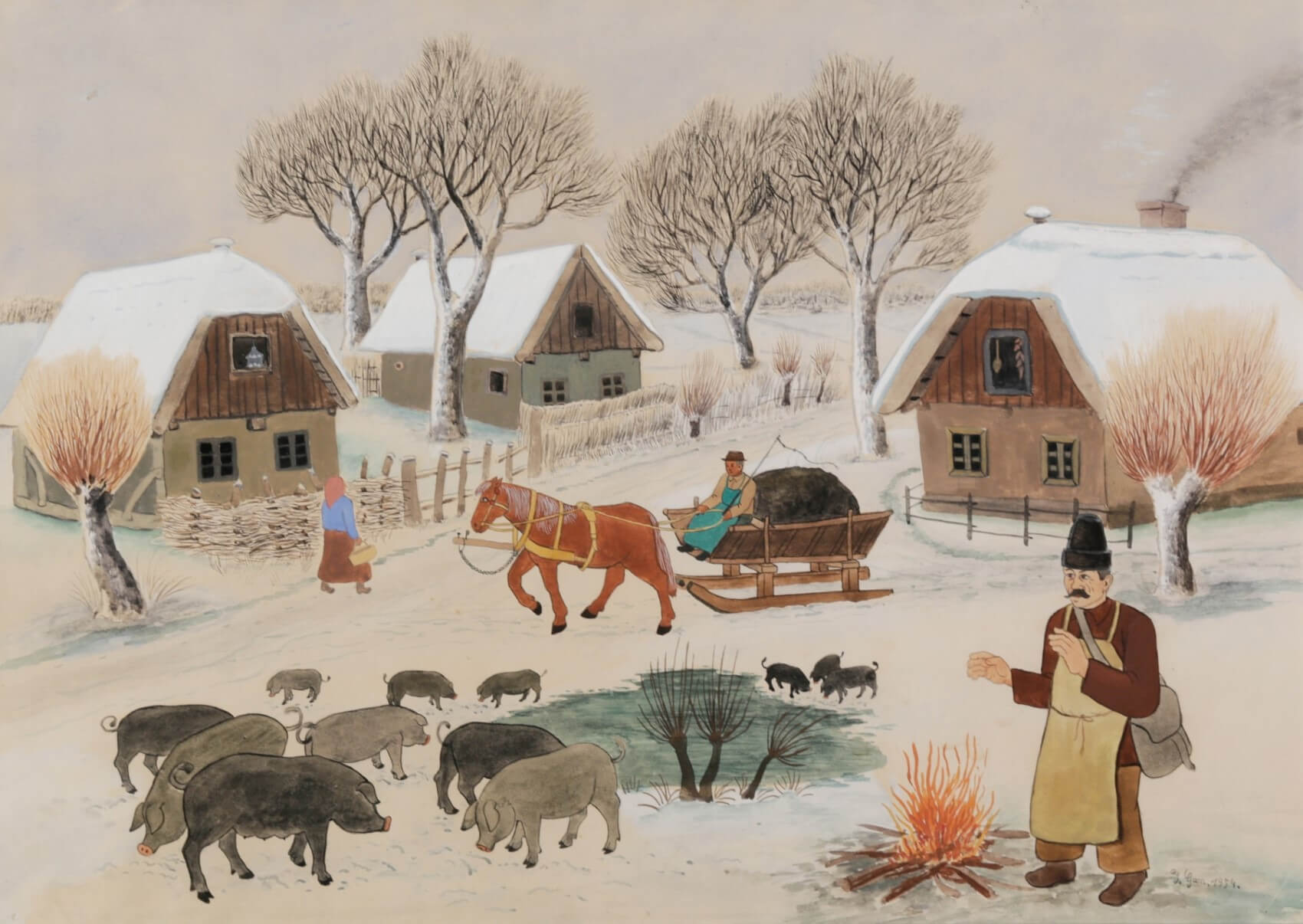 'Kanas' by Ivan Generalić, hanging at the Galerija naivne umjetnosti (Gallery of Naive Art), Hlebine © Koprivnica Town Museum
'Kanas' by Ivan Generalić, hanging at the Galerija naivne umjetnosti (Gallery of Naive Art), Hlebine © Koprivnica Town Museum
Within its first generation, the three most prominent artists are Ivan Generalić, Franjo Mraz and Mirko Virius. Both Ivan Generalić and Franjo Mraz were born, lived and were discovered by Krsto Hegedušić in the village of Hlebine. Mirko Virius was from Đelekovec, less than 15 kilometres to their north-west.
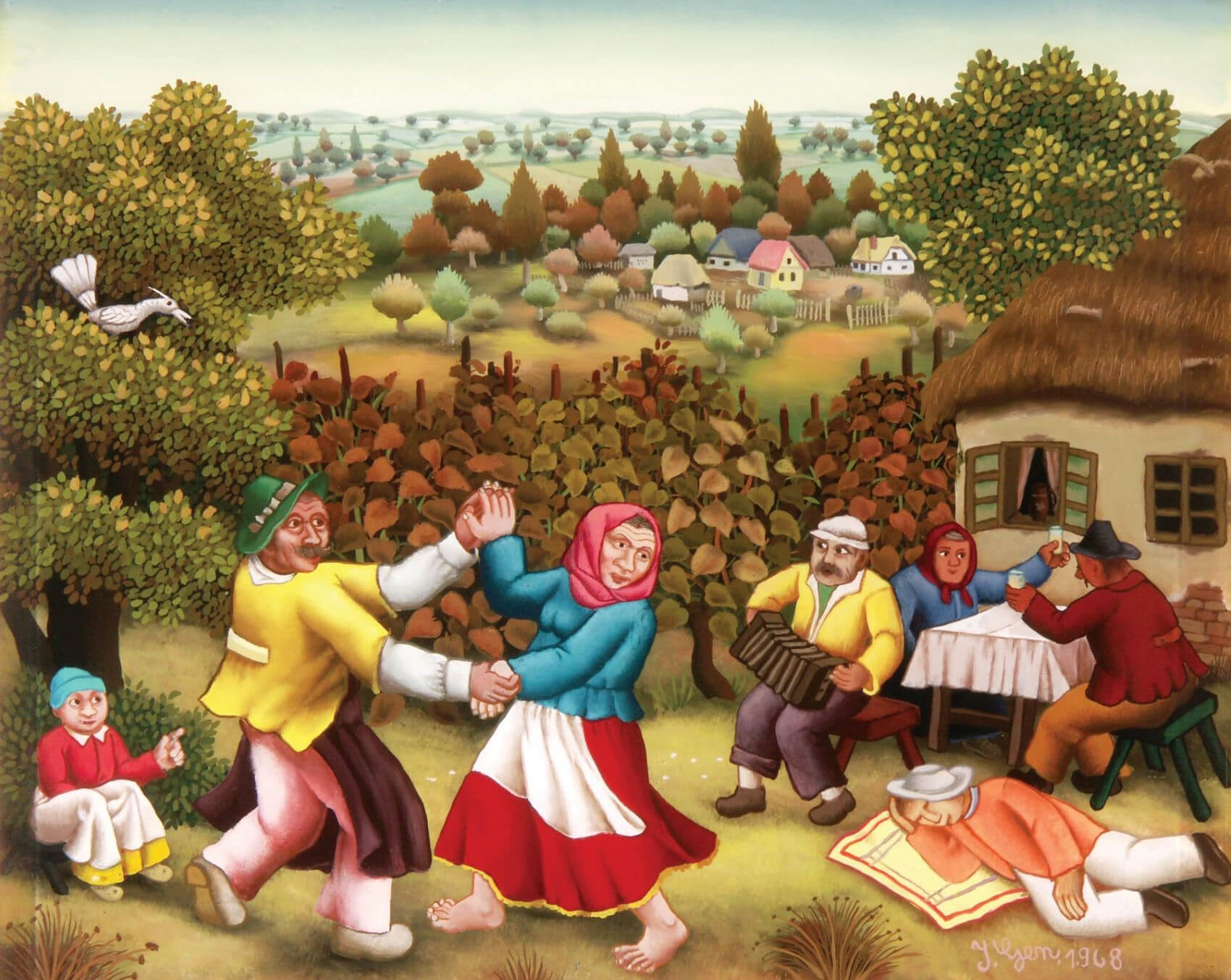 'Ples v goricaj' by Ivan Generalić, hanging at the Galerija naivne umjetnosti (Gallery of Naive Art), Hlebine © Koprivnica Town Museum
'Ples v goricaj' by Ivan Generalić, hanging at the Galerija naivne umjetnosti (Gallery of Naive Art), Hlebine © Koprivnica Town Museum
Key to identifying the Hlebine School in its First Generation is the subject matter. All three of these artists painted the world around them – their neighbours and peers, living everyday lives, in the villages, landscape and towns of today's Koprivnica-Križevci County. Certainly, Krsto Hegedušić helped inspire this subject matter, moulding the artists to suit the ethos of the Earth Group.
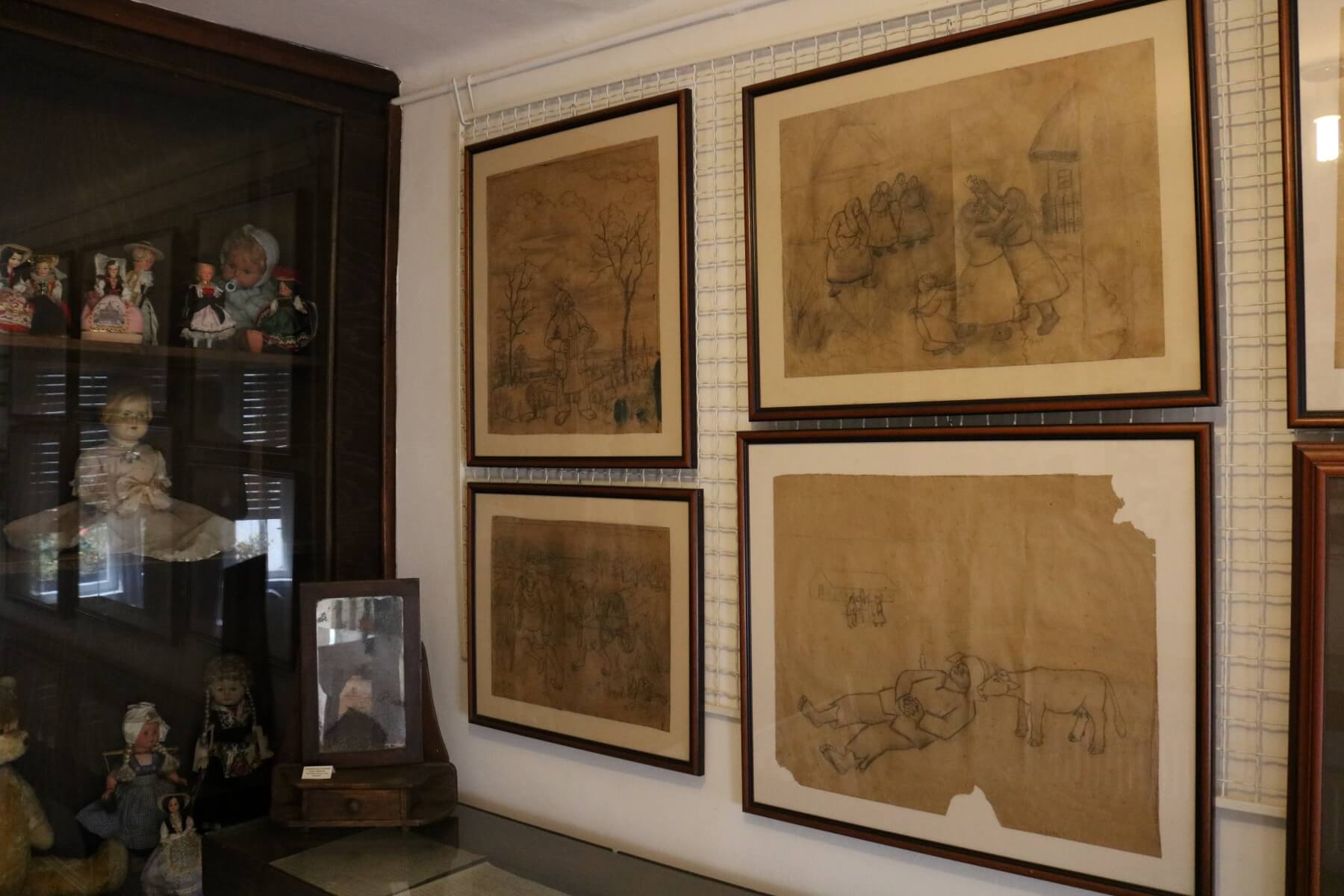
Ivan Generalić was just 16 years old when discovered by Krsto Hegedušić in 1930. The meeting would have a fast and long-lasting impact on Generalić. Ivan's humble early canvasses were the brown paper bags used in the business of a close relative. Yet, within a year of meeting Hegedušić, Ivan Generalić found his work being exhibited in Zagreb.
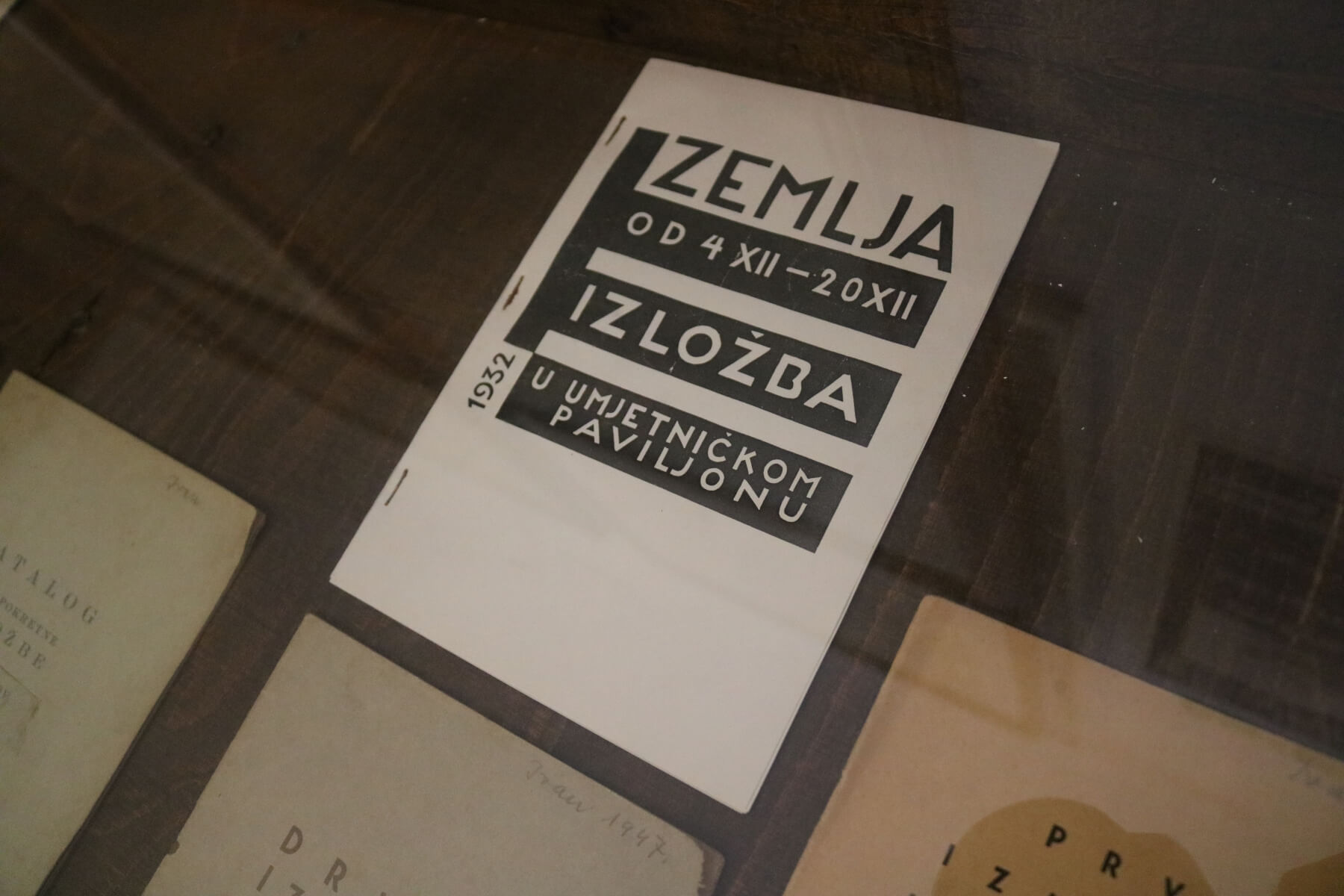
Hegedušić's shaping of the artists didn't obliterate their existing perspectives as much as it simply shifted them. For instance, Hegedušić's advice might have been "Instead of painting the church, why not paint people walking to the church in the snow?" or "Instead of marking the religious holiday by painting its origin story, why not show how you and your neighbours celebrate this holiday?"
Whether Hegedušić was conscious of doing it, or whether the artists were willfully lead, this guidance ultimately had the effect of politicising their work. In turn, this would lead the most authentic of all Croatian art into dangerous times when fascists took over the country. Proletarian in their themes, the Hlebine School and the Earth Group became viewed as Communist. The latter group was banned and Hegedušić arrested several times. During the Second World War, Mirko Virius was arrested, taken to a concentration camp in Zemun and executed. Ivan Generalić's painting of the sorrowful incident, 'The Death of Virius', is among his most famous. Franjo Mraz was also arrested during World War II but managed to escape.
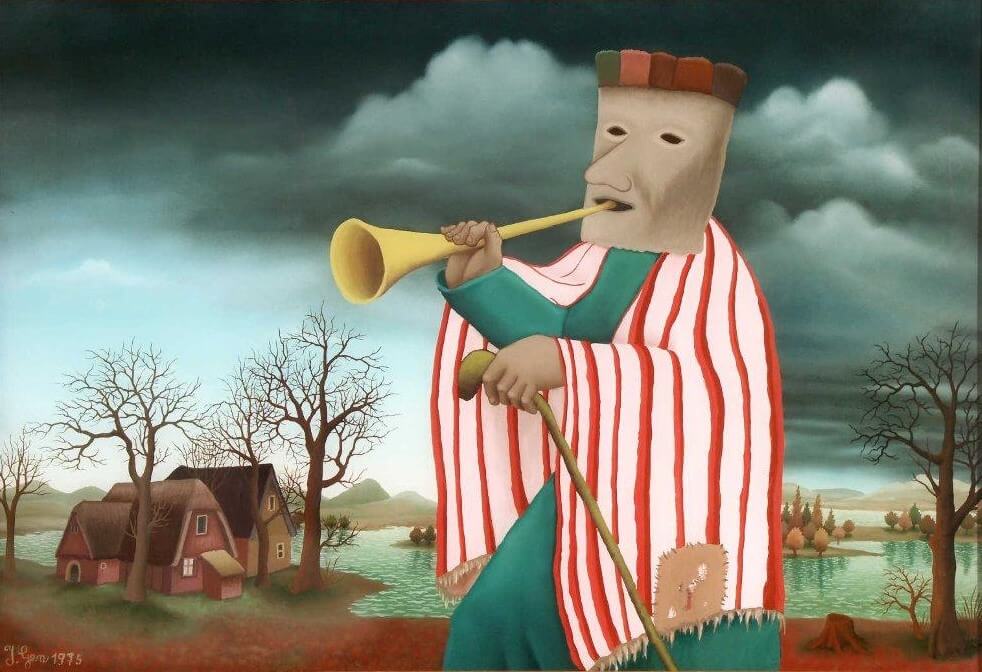 'Mask' by Ivan Generalić, hanging at the Galerija naivne umjetnosti (Gallery of Naive Art), Hlebine © Koprivnica Town Museum
'Mask' by Ivan Generalić, hanging at the Galerija naivne umjetnosti (Gallery of Naive Art), Hlebine © Koprivnica Town Museum
Aside from informing the subject matter of their work, Hegedušić also educated the painters in different techniques. One of these techniques – painting on glass – would become an enduring component of the Hlebine School and Croatian Naive Art.
Painting on glass
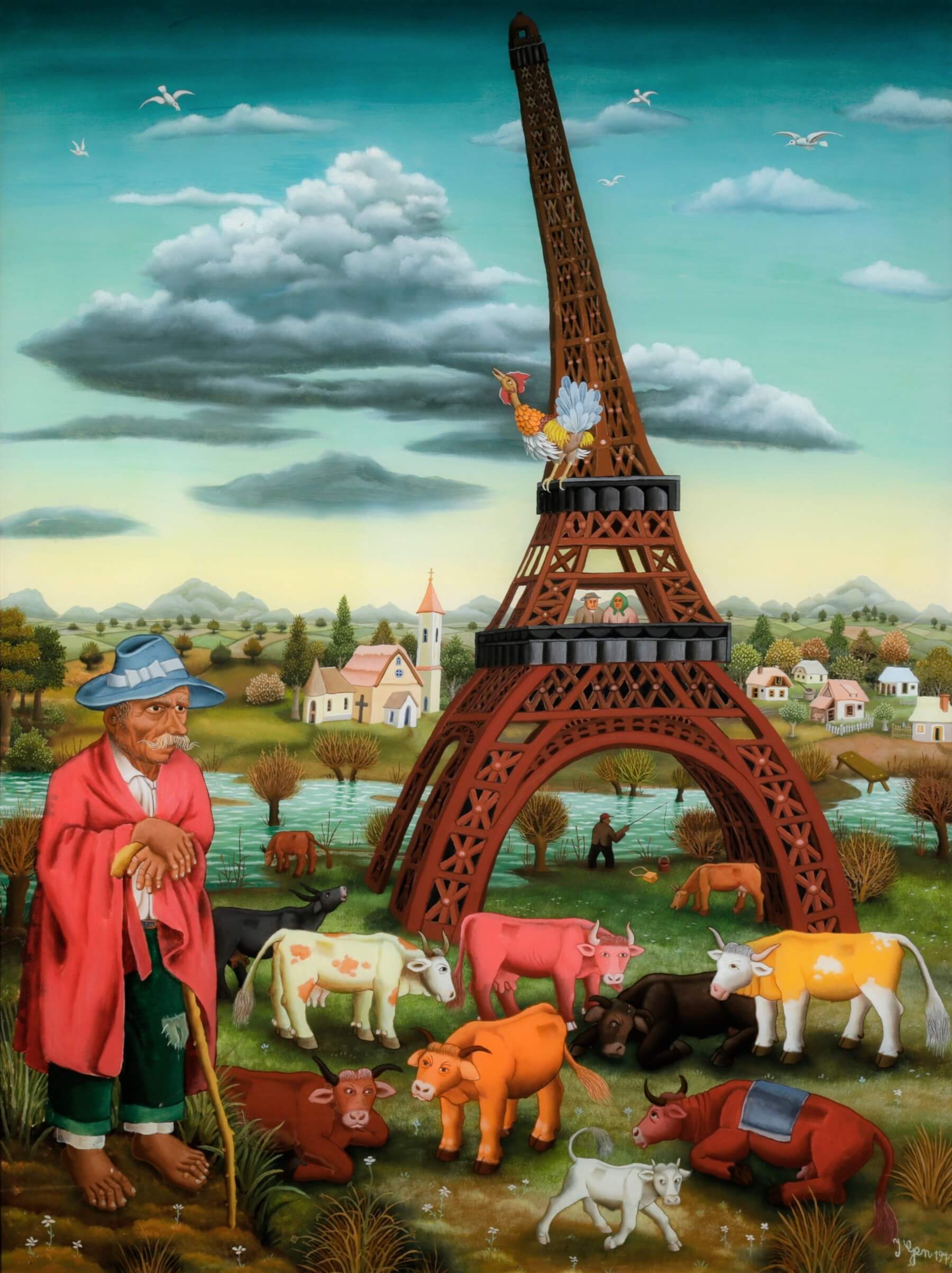 'Eiffel Tower' by Ivan Generalić. The original hangs at Galerija naivne umjetnosti (Gallery of Naive Art), Hlebine © Koprivnica Town Museum
'Eiffel Tower' by Ivan Generalić. The original hangs at Galerija naivne umjetnosti (Gallery of Naive Art), Hlebine © Koprivnica Town Museum
Copying the style from imported religious art, when Hlebine School artists learned to paint on glass, it gave their efforts several distinct qualities. Firstly, if stored in the right conditions – away from damaging light – the glass protects the colours of the paint. As a result, much Hlebine School art is as brilliantly vivid today as the day it was first painted.
Secondly, this format makes the works heavy and fragile. Several masterpieces have been lost by falling to the floor and smashing.
Thirdly, painting on glass is time-consuming and challenging. Each painting must be thought out and planned in advance. The painter initially makes a sketch or preliminary painting as a guide. The image is then transferred to glass effectively in reverse. Details in the forefront of the painting must be applied first, with the background painted on top. Throughout the process, the artist will continuously check their progress on the opposite side of the glass.
Hlebine School Second Generation and onwards: Josip Generalić, Ivan Večenaj, Ivan Lacković, Mijo Kovačić, Franjo Filipović, Dragan Gaži
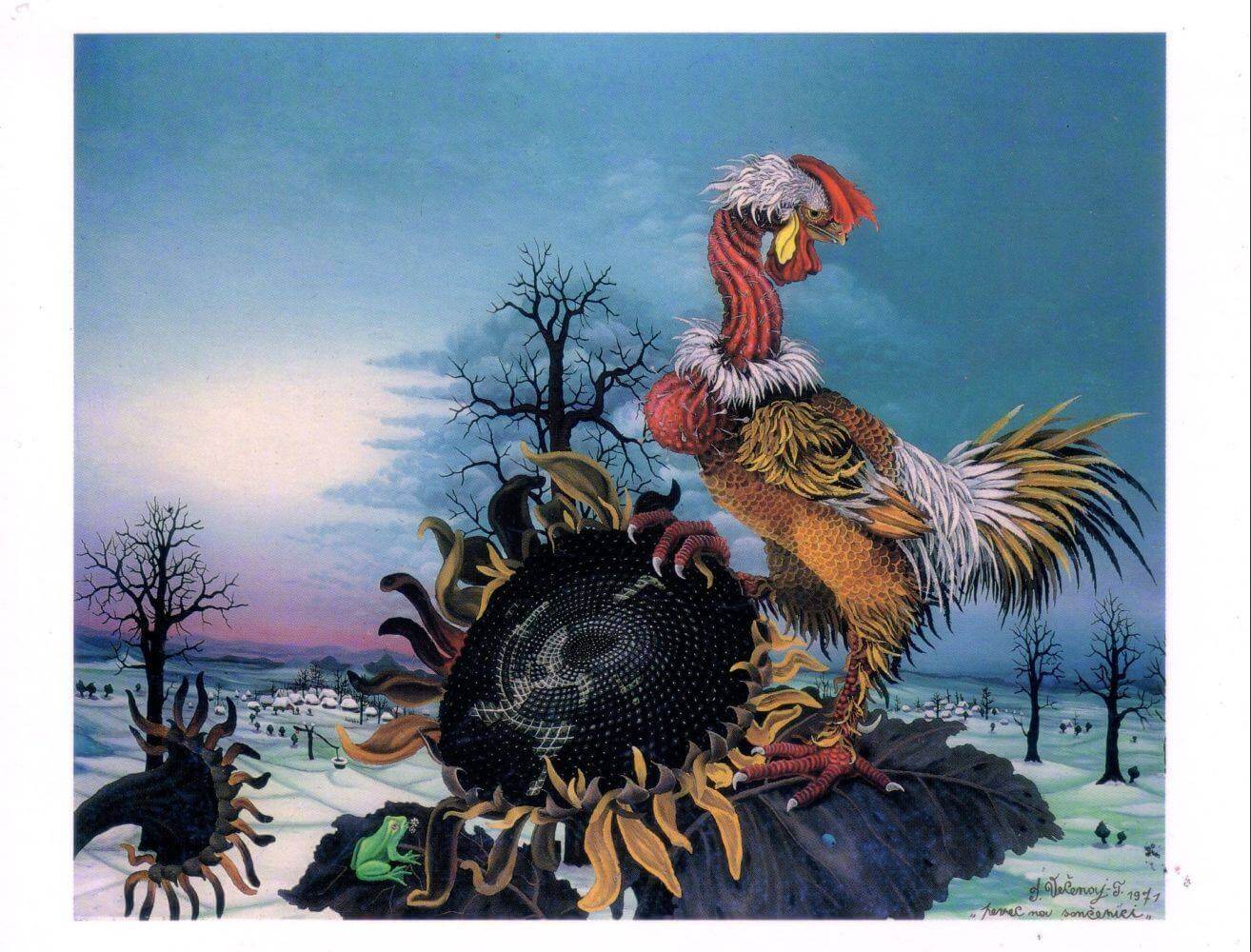 Rooster on Sunflower by Ivan Večenaj © Galerija Ivan Večenaj
Rooster on Sunflower by Ivan Večenaj © Galerija Ivan Večenaj
Perhaps to their surprise, the painters of Hlebine School first generation became a big hit. Exhibitions of their work were appreciated first in Zagreb. But, then the exhibitions began to tour across Yugoslavia and eventually the art capitals of the world. This attention would help inspire a new generation of artists from Hlebine and the surrounding area.
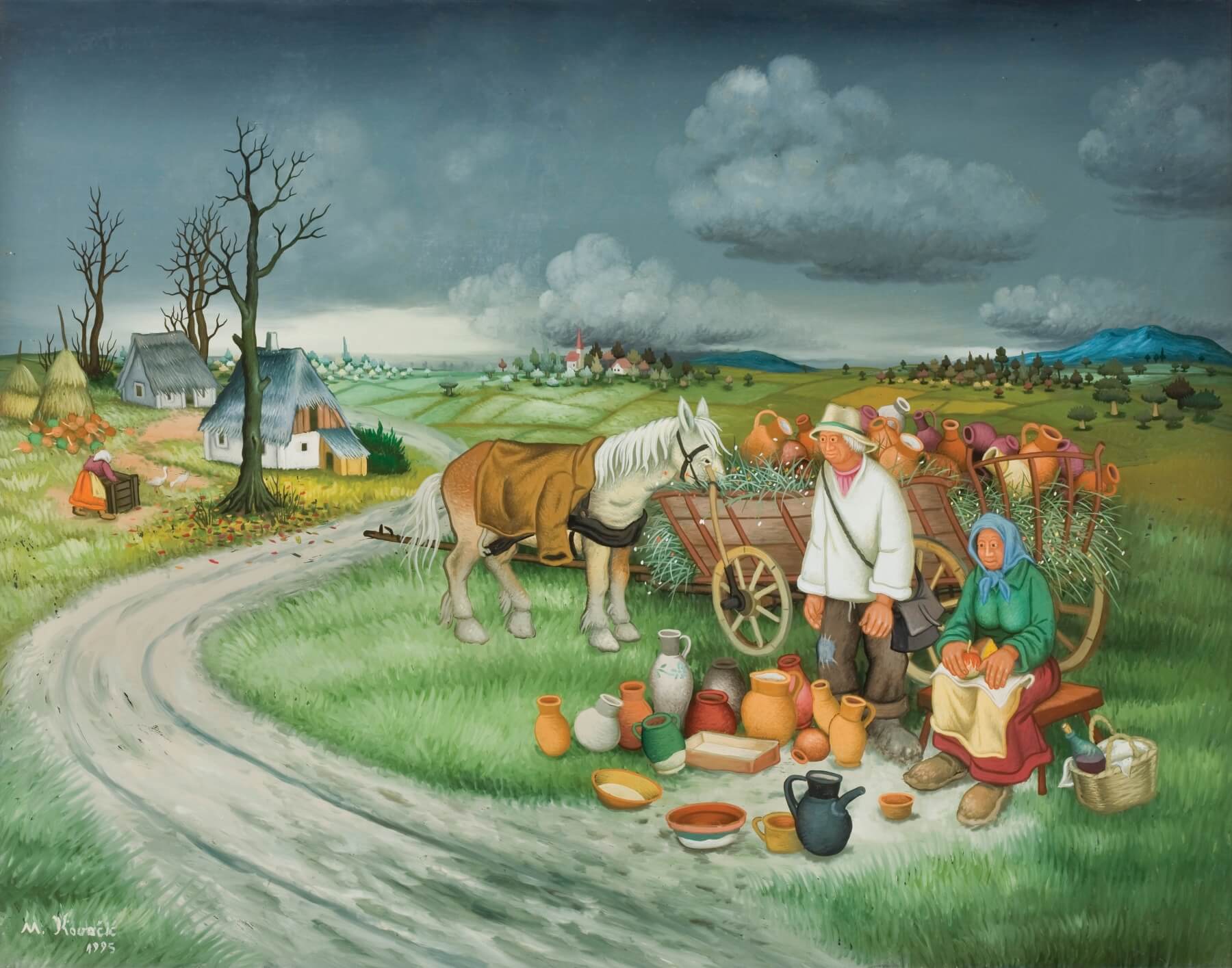 'Lončari' by Mijo Kovačić at Galerija Mijo Kovačić © Koprivnica Town Museum
'Lončari' by Mijo Kovačić at Galerija Mijo Kovačić © Koprivnica Town Museum
Success for the Hlebine School artists showed that Croatian art and self-expression were valid and valued even if unstudied. Thereafter, the tiny village of Hlebine would never look the same. More and more Naive Artists and folk artists were inspired to create. Still to this day, many continue.
While some Hlebine School artists carried on the tradition of painting on glass, others were inspired to sculpt in wood or, like Mirko Virius, paint on canvas. One of the key distinctions between later generations of the Hlebine School and the first is the subject matter.
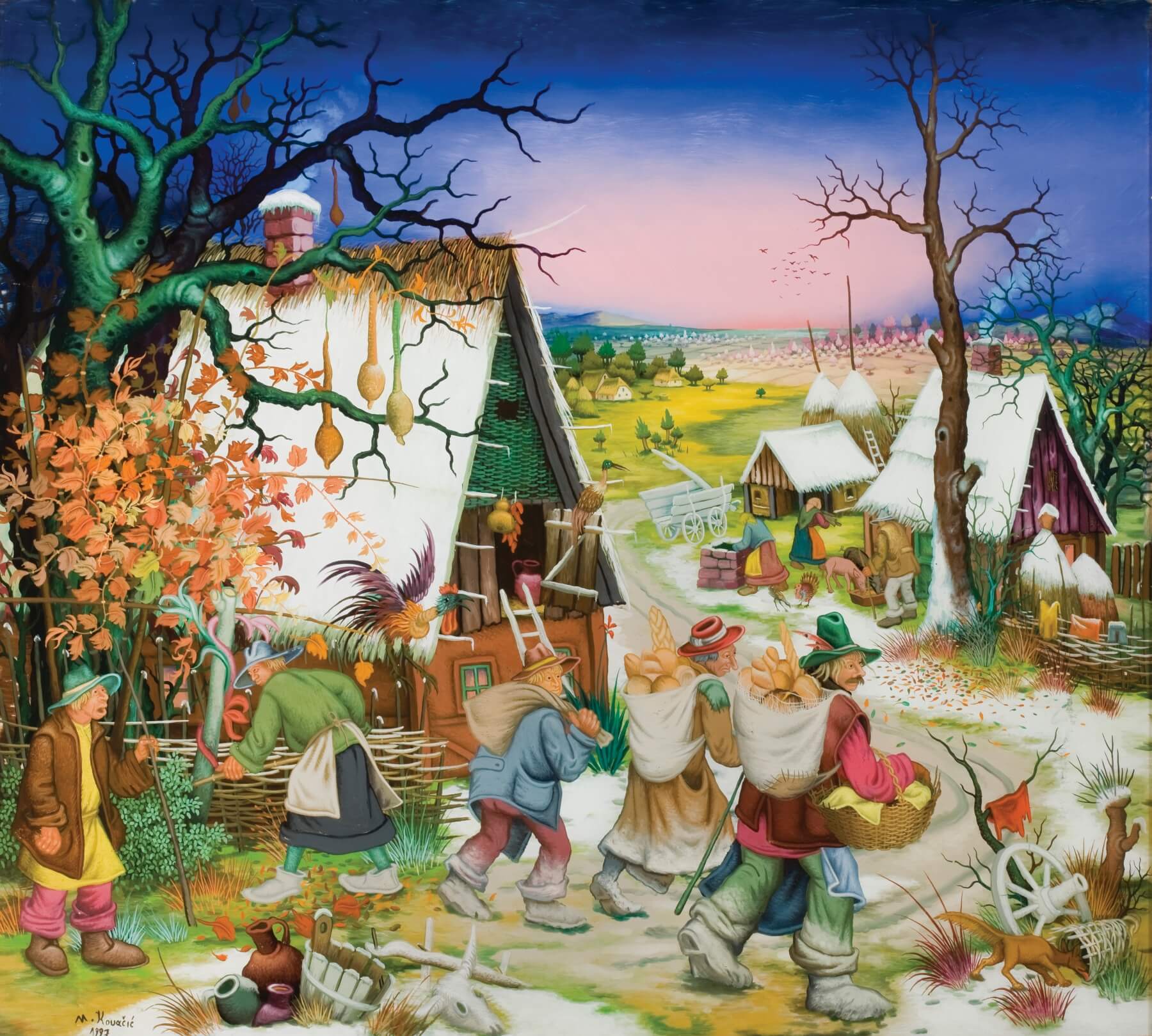 Podravina bread sellers in a picture hanging at Galerija Mijo Kovačić © Koprivnica Town Museum
Podravina bread sellers in a picture hanging at Galerija Mijo Kovačić © Koprivnica Town Museum
Second and then third generation Hlebine School artists were inspired to paint folklore, fantasy, from imagination, and with symbolic uses of vivid colur. This broadening of the style was partially the influence of Dimitrije Bašičević Mangelos, the first curator of the Gallery of Primitive Art in Zagreb (today Croatian Museum of Naïve Art). Subsequently, many of these later works would not fit within the paradigms of the Earth Group.
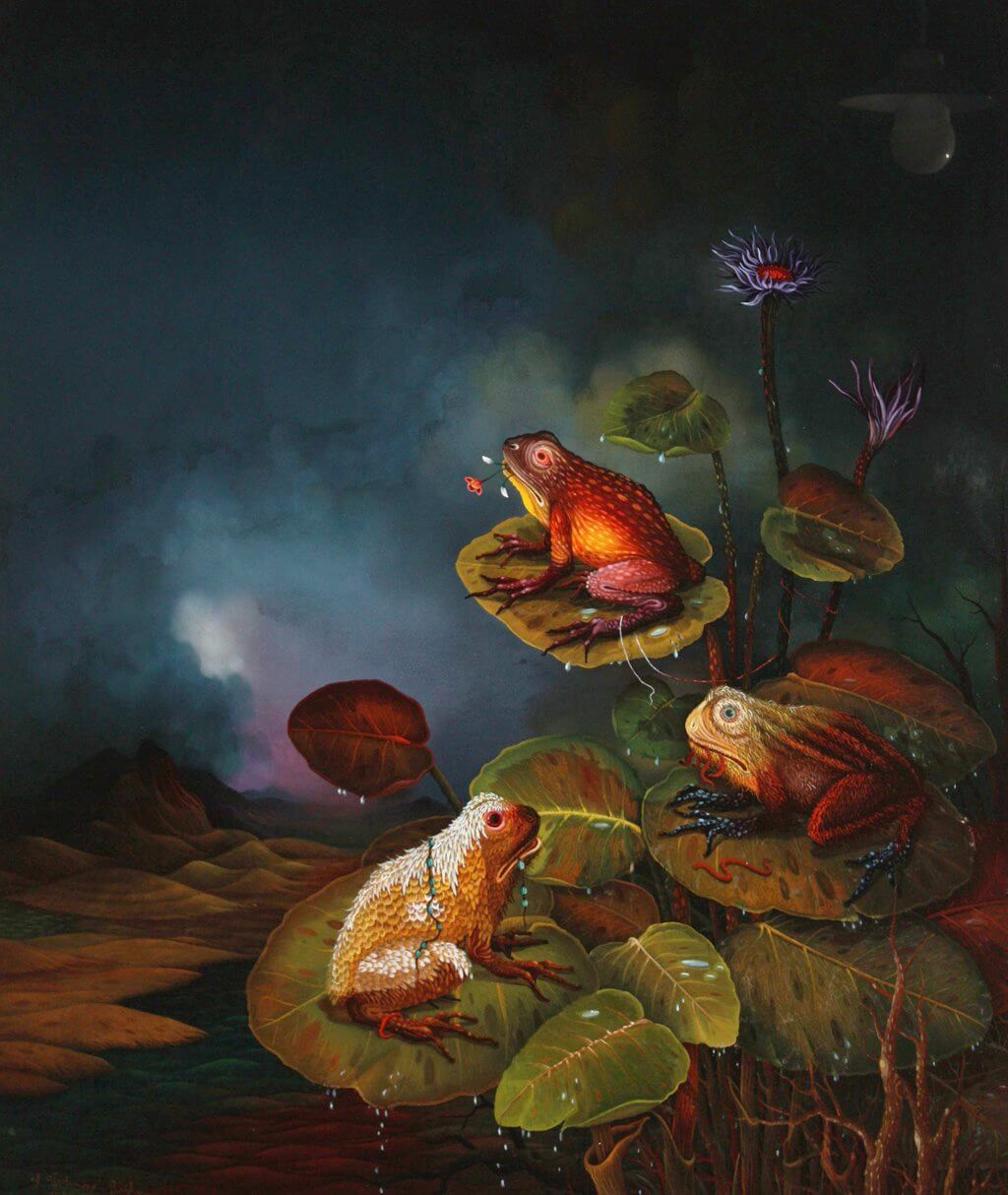 'Žabe (Frogs)' by Ivan Večenaj © Galerija Ivan Večenaj
'Žabe (Frogs)' by Ivan Večenaj © Galerija Ivan Večenaj
For example, some of Ivan Večenaj's sacral paintings clearly come from the author's imagination and not his actual vision. Similarly, Josip Generalić, son of Ivan, travelled far beyond the limits of his home village in pursuit of his socio-political subject matter. Both artists were concerned with environmental issues on a global, not just a local level. Although, their work is still inextricably linked to their locale; Večenaj works the Podravina rooster emblem into many of his paintings and even depicts Christ within a Podravina landscape. So too does Josip Generalić when he paints The Beatles and others from the 60s counterculture movement.
On the Trail of the Hlebine School in Podravina & Prigorje, Home of the Treasures of Croatian Naive Art
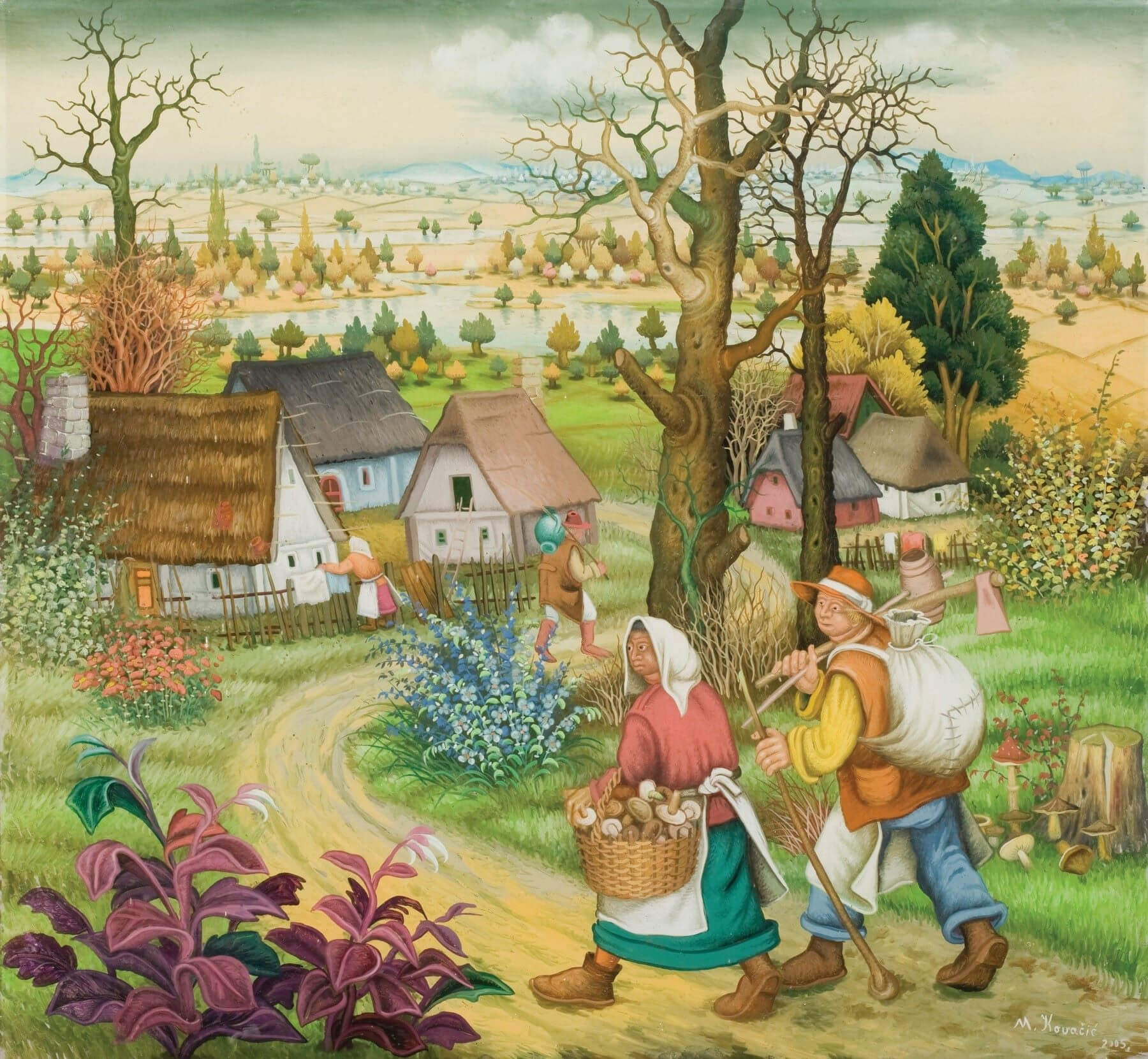 Locals return from mushroom picking in autumnal Podravina in a picture hanging at Galerija Mijo Kovačić © Koprivnica Town Museum
Locals return from mushroom picking in autumnal Podravina in a picture hanging at Galerija Mijo Kovačić © Koprivnica Town Museum
Some Croatian Naive Art is held in private and public collections across the world. Some of it finds a home in the National Museum of Naive Art in Zagreb. However, the vast majority of treasures from the Hlebine School of Croatian Naive Art remain in Podravina & Prigorje. The national Museum of Naive Art in Zagreb is currently closed as it undergoes the lengthy process of changing address. As a result, the following addresses in Koprivnica-Križevci County are currently the best places to see the most authentically Croatian of all the country's art.
Also, because the landscape of Hlebine, Koprivnica and wider Podravina appears in so much Hlebine School art, you genuinely need to come here to view both together. You'll get a much better understanding and appreciation of this art when you see it in its natural surroundings.
Galerija Mijo Kovačić, Koprivnica Town Museum, Koprivnica
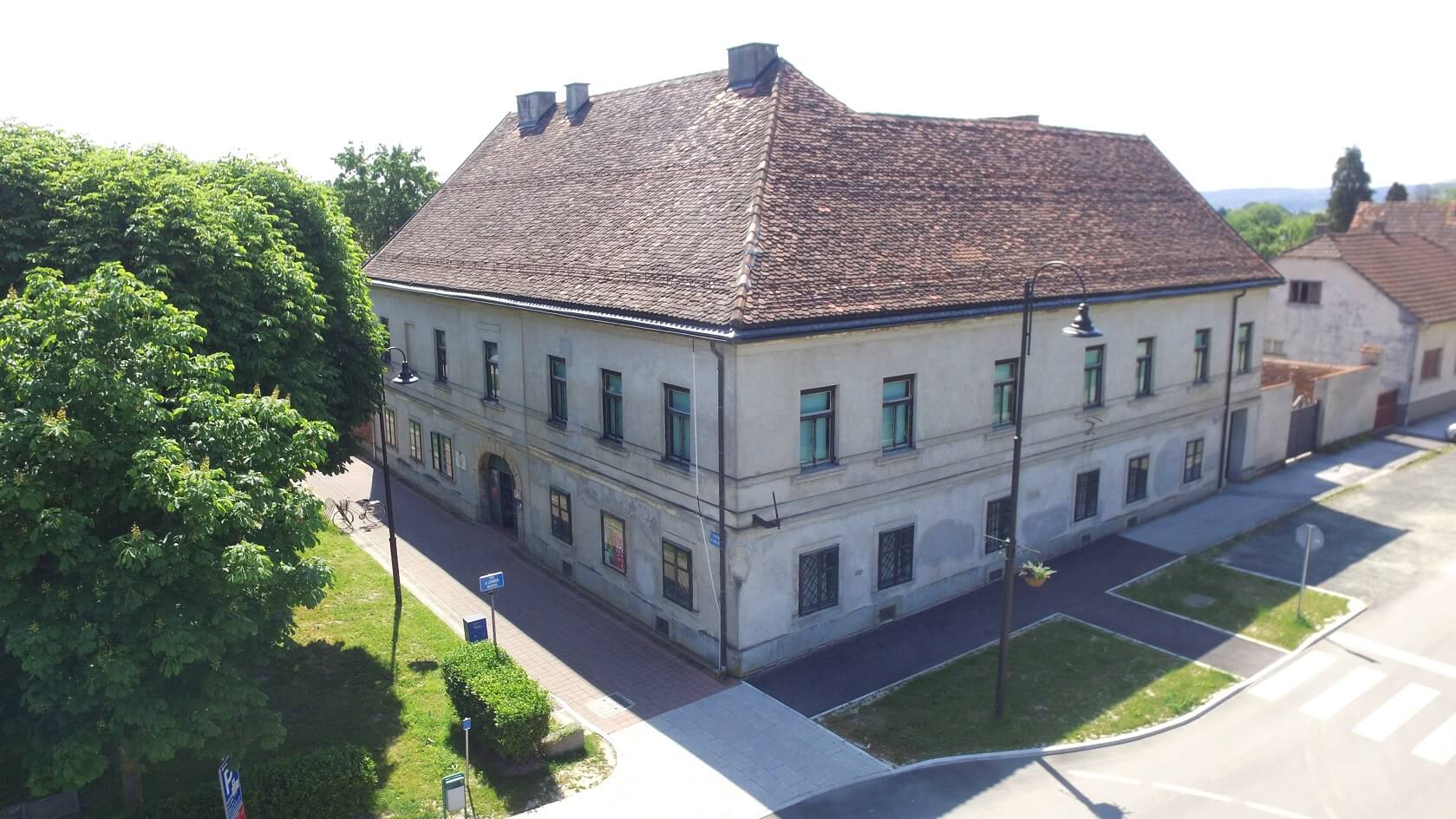 Koprivnica Town Museum © Koprivnica Town Museum
Koprivnica Town Museum © Koprivnica Town Museum
Born 5 August 1935 in Gornja Šuma, Molve, Podravina, Mijo Kovačić is one of the last remaining Croatian Naive Artists of the Hlebine School's second generation. He still paints today, albeit not quite as prolifically as in the past. He has produced such a body of work that not only can you find him exhibited in Croatian Museum of Naïve Art in Zagreb, but also in dedicated Mijo Kovačić galleries in Zagreb and Koprivnica. The one is run by Koprivnica Town Museum, which you can see above. Find out more about the gallery here.
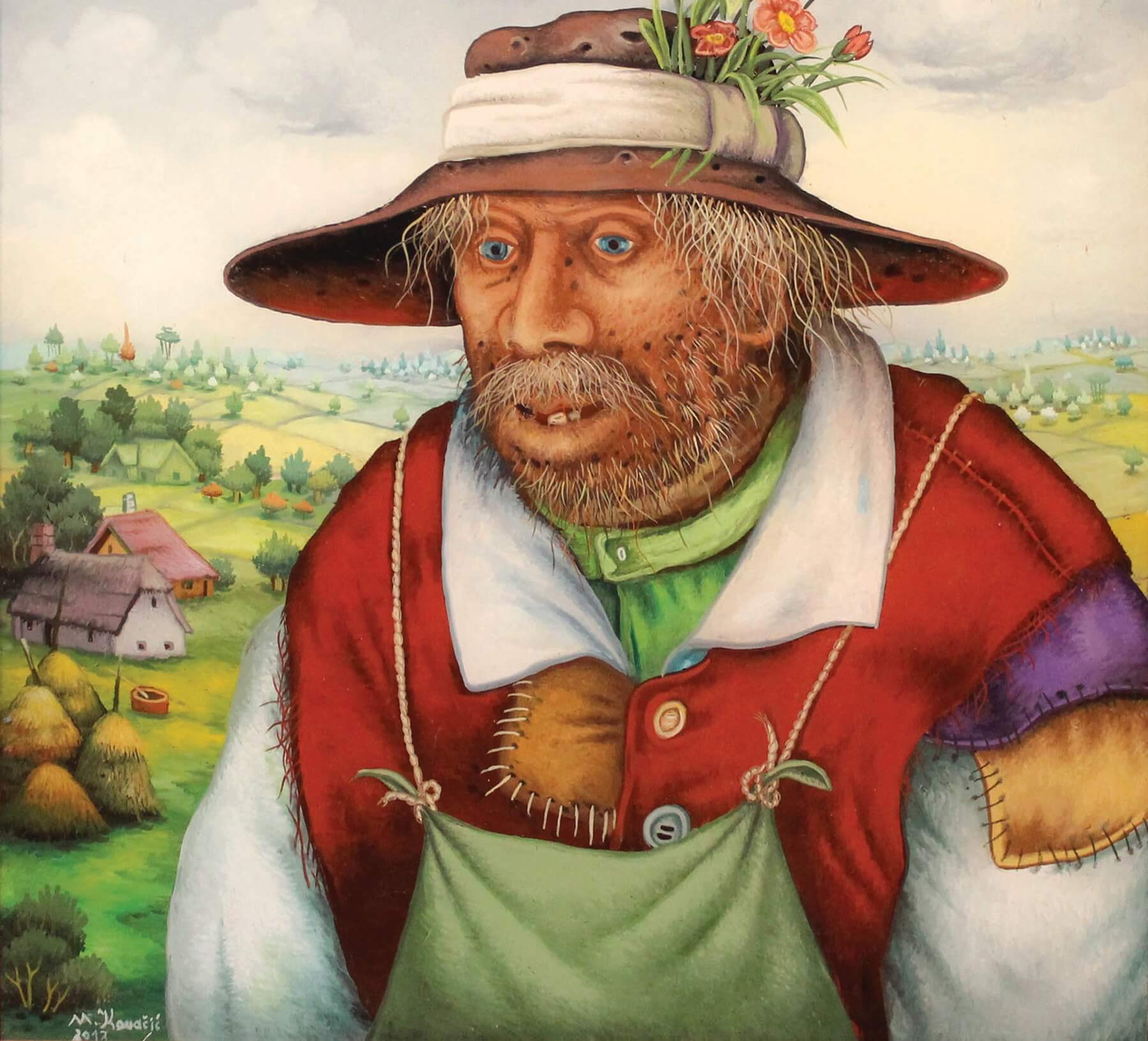 'Portrait' hanging at Galerija Mijo Kovačić © Koprivnica Town Museum
'Portrait' hanging at Galerija Mijo Kovačić © Koprivnica Town Museum
Galerija naivne umjetnosti (Gallery of Naive Art), Hlebine
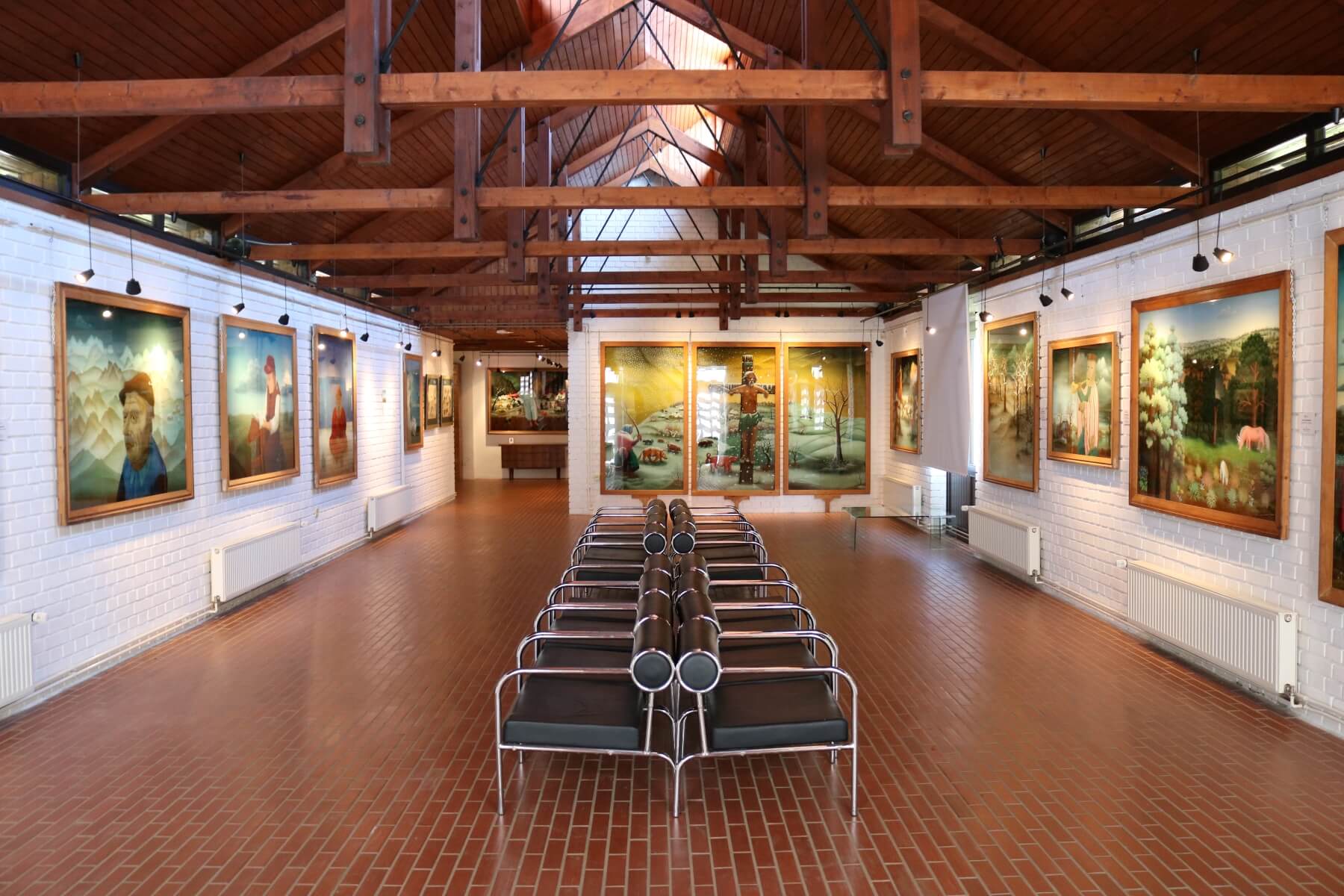
Founded in 1968, the Gallery of Naive Art in Hlebine is one of the top two most important galleries for Naïve Art in Croatia, the other being the Croatian Museum of Naïve Art in Zagreb. But, unlike their Zagreb counterpart, this gallery concentrates specifically on the Hlebine School and locally produced art. A crowd of sculpted wooden figures greets you on the front lawn. Inside, beneath the wooden beams of a beautiful building designed specifically for this purpose, some of the best artists and paintings of the Hlebine School.
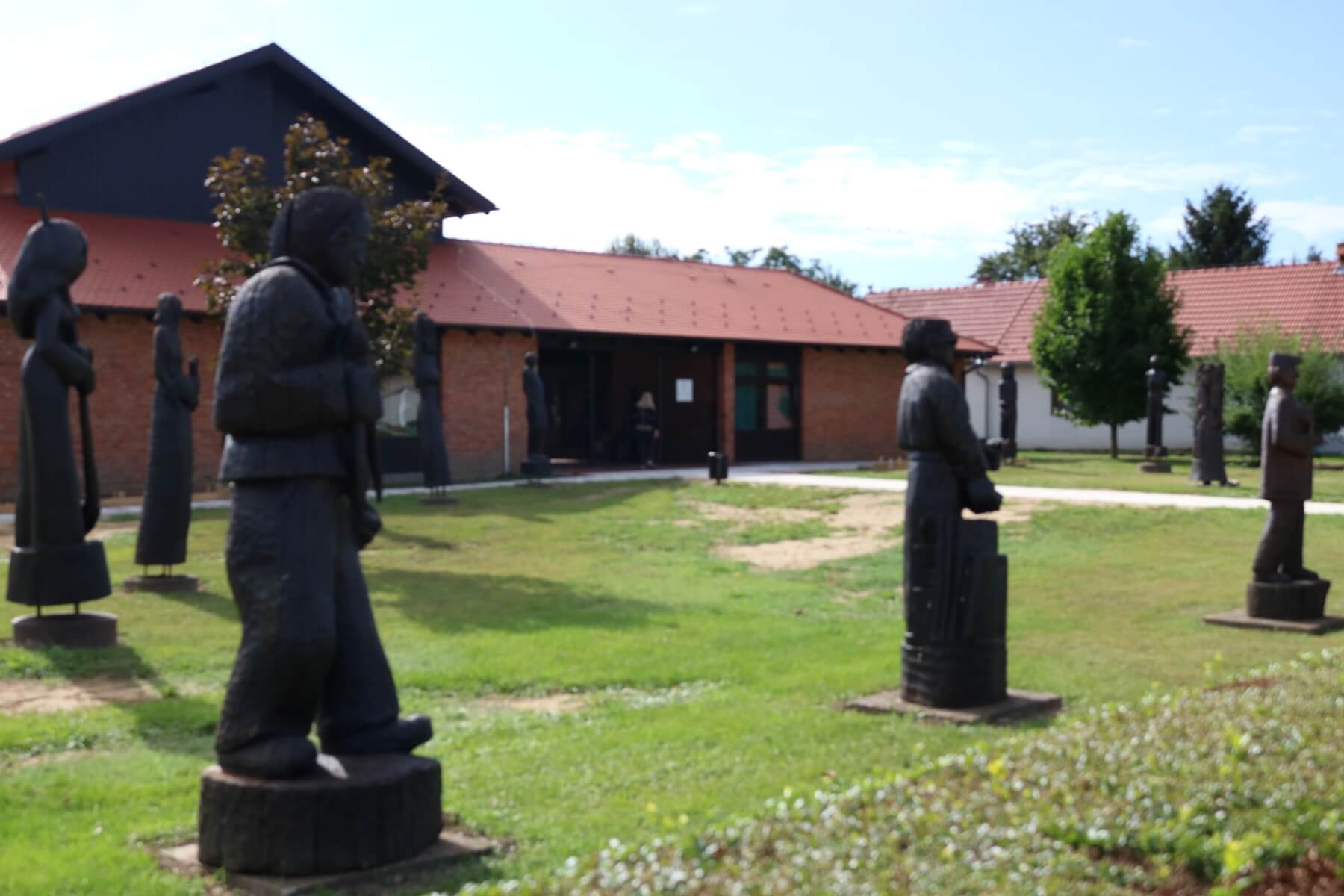
In the mid-1980s, when he was the most famous of all Croatian Naive Artists, neighbour Ivan Generalić paid the gallery a visit. He offered to pay for an extension to the gallery, on condition that it be used to house a permanent exhibition of his work. It was a win-win for the museum and Ivan Generalić subsequently donated some of his true masterpieces for the collection.
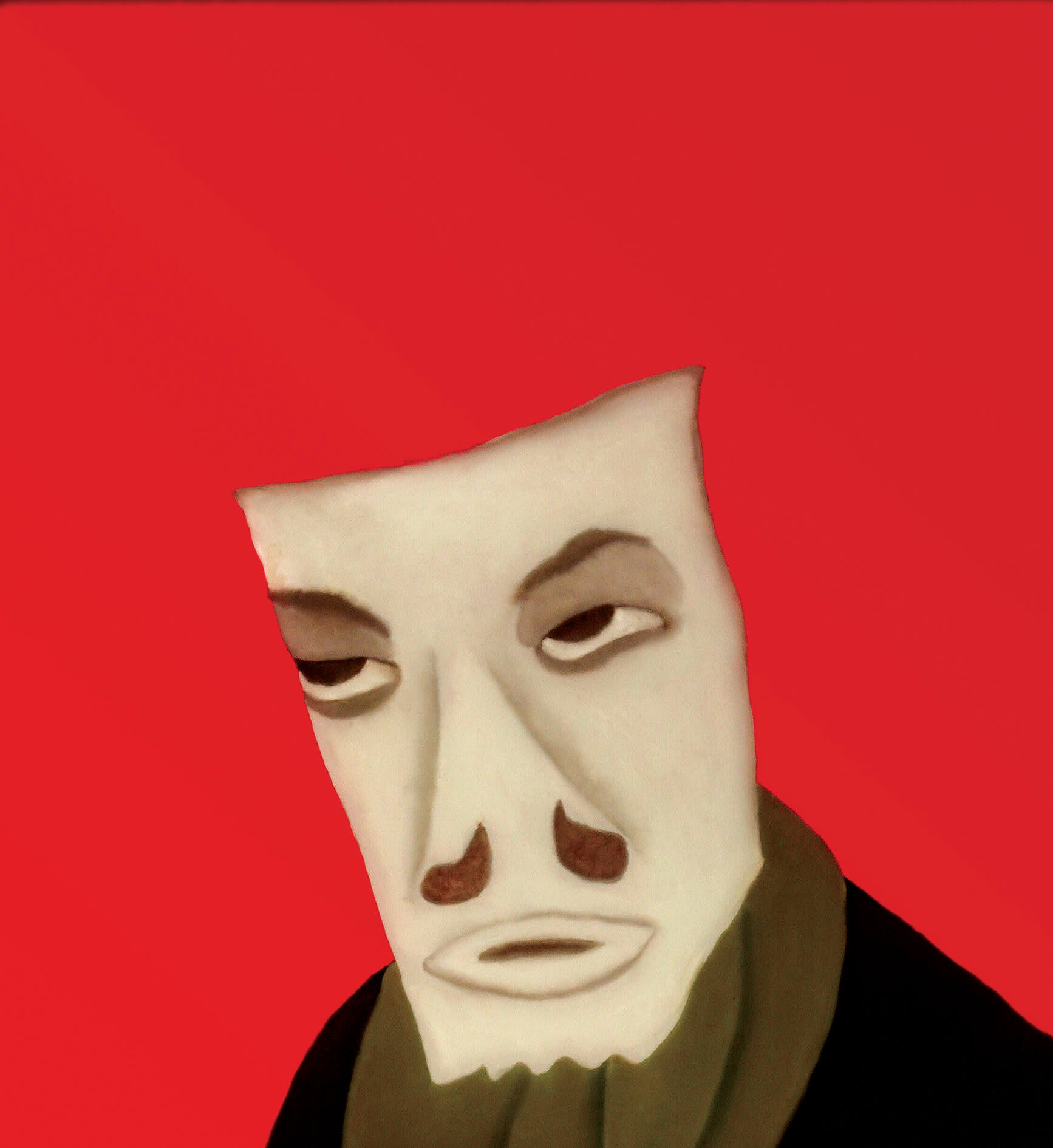
The newer part of the gallery is so true to the original design that, unless informed, you'd never guess it was built later. You'll find works by every key member of the Hlebine School here, including Ivan Generalić, Franjo Mraz and Mirko Virius, Josip Generalić, Ivan Večenaj, Ivan Lacković, Mijo Kovačić, Franjo Filipović and Dragan Gaži. Today, the museum is run by Koprivnica Town Museum. Find out more about the gallery here.
Galerija Josip Generalić, Hlebine
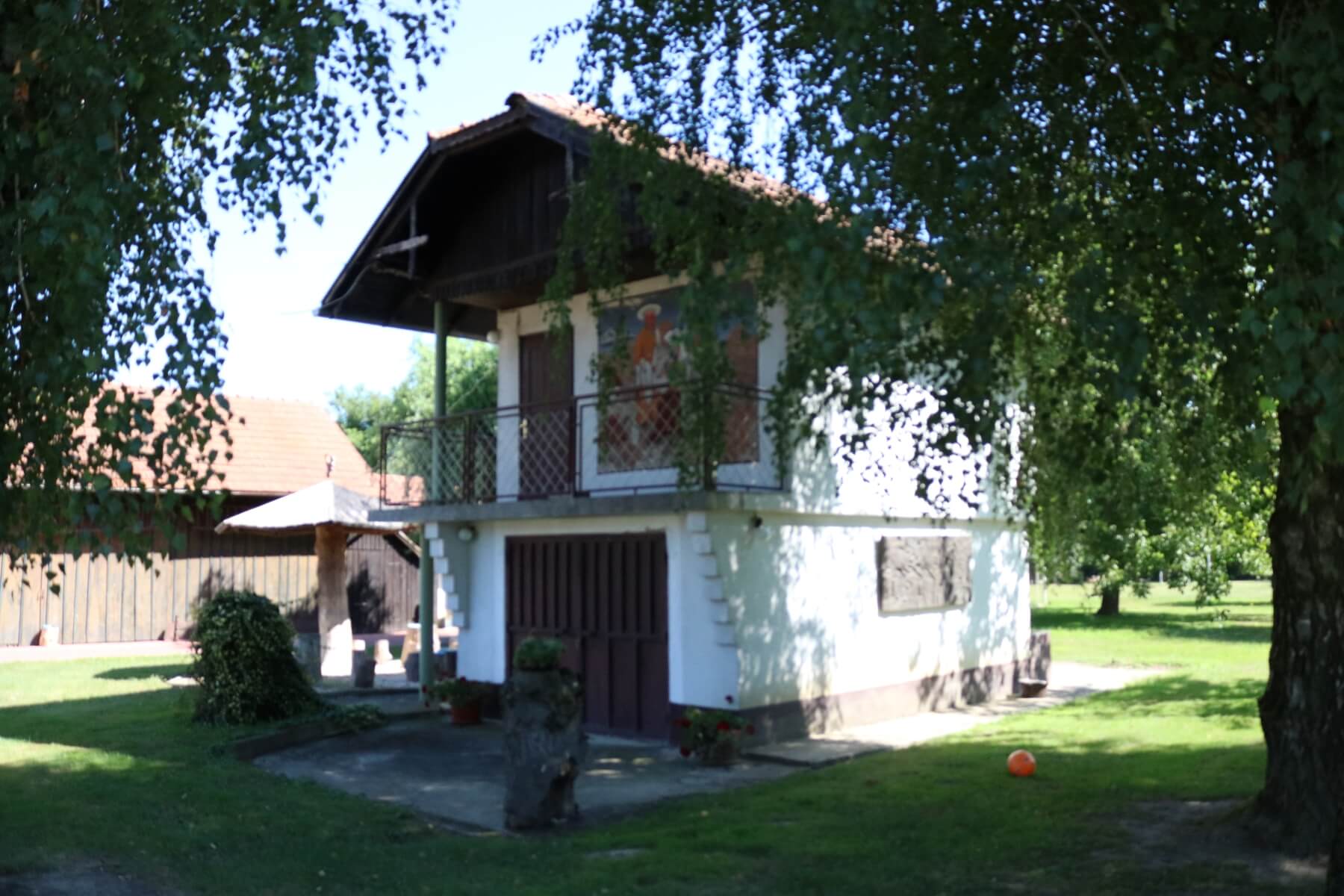
“How long have you got?” asks Ivan Generalić, grandson of Josip Generalić, great-grandson of Ivan Generalić, as he greets you at the Galerija Josip Generalić, Hlebine. He's asking if there's time for the1 hour tour or 6-hour tour. We think he's joking. He's not.
Generalić family have lived here for at least five generations. Having two of the Hlebine School's most famous and most successful painters within their ranks has allowed them to expand their property portfolio. It's just as well, because there's a lot to see here. What was once the simple, semi-agricultural farmstead where Ivan's great grandfather was born is now a sprawling family estate that houses an ethno-museum and considerable gallery spaces filled with incredible exhibits. All of the original furniture from how his great grandfather lived is preserved, displayed as it was, only in an adjoining property the family now own. Alongside the history and many works of Ivan Generalić and Josip Generalić, folk art, sculpture and artisan furniture made by incredible craftsmen from across the Balkans, who the painters once traded with.
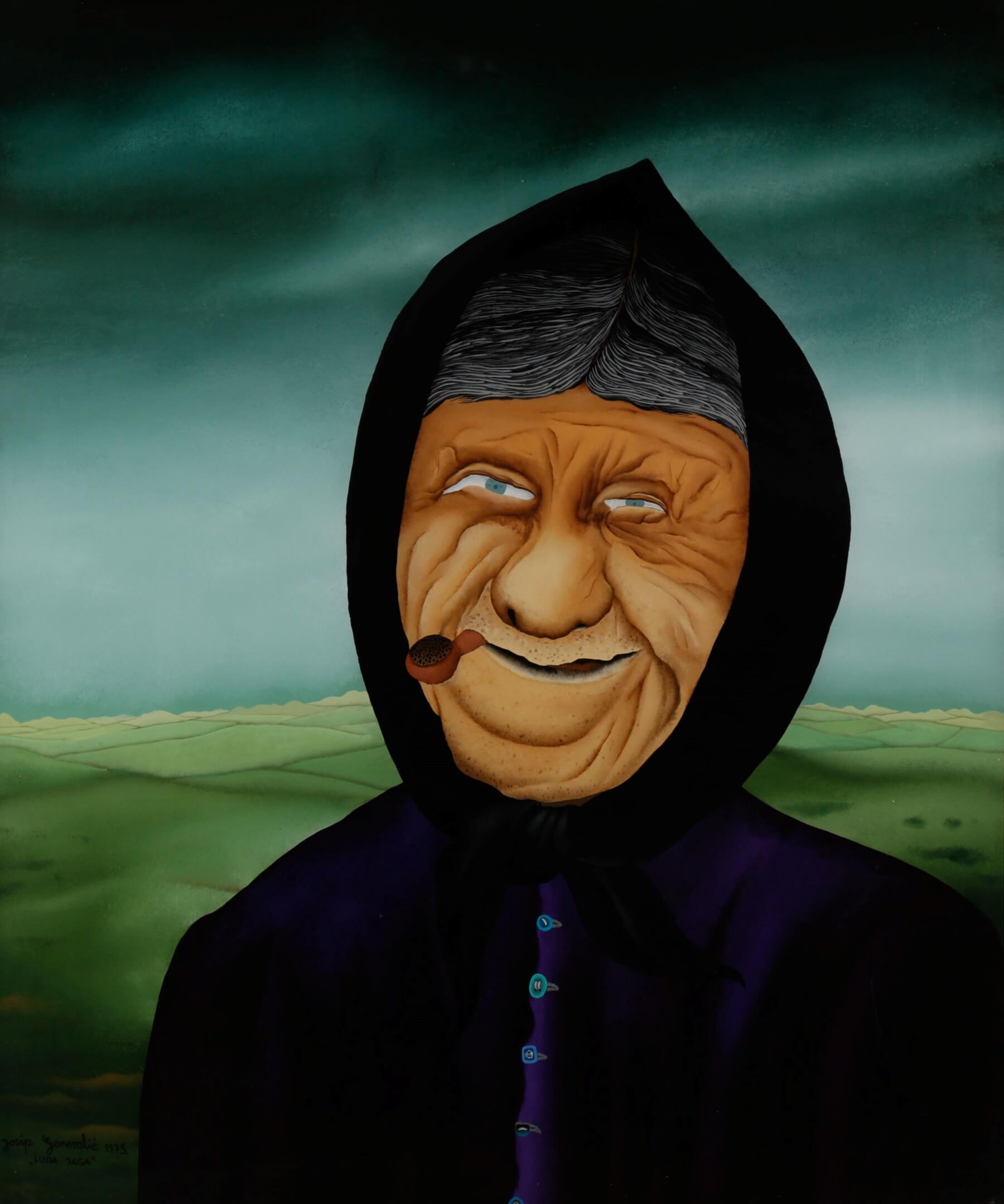 Luda Jaga by Josip Generalić, hanging at the Galerija naivne umjetnosti (Gallery of Naive Art), Hlebine © Koprivnica Town Museum
Luda Jaga by Josip Generalić, hanging at the Galerija naivne umjetnosti (Gallery of Naive Art), Hlebine © Koprivnica Town Museum
If you already like this kind of art, you might have to pinch yourself more than once that you're being shown around by someone called Ivan Generalić. Ivan himself is not only knowledgeable but extremely engaging - there are several big laughs on the tour. Ivan points out one image of an unloved neighbour, who grandfather Josip sent to the moon. He provides him with a Podravina cow so at least he can survive. Perhaps feeling slightly guilty, in the next room, Josip has painted the neighbour's return to earth. Although, he lands nearby in the famously barren Đurđevac desert (sometimes known as the Croatian Sahara). That's quite a lot of time and paint spent on someone you don't like!
Ivan's great grandfather also had a sense of humour. Having grown tired of friends bragging about their holidays in summer houses on the Croatian coast (which he did not like), at the height of his fame he decided to build his own. He invited several friends to accompany him on his holiday. And proceeded to take them to his own back garden, just metres from his main residence, where he had built the summer house. Genuinely, you'll wish you had time for the 6-hour tour. Find out more about the gallery here.
Galerija Ivan Večenaj, Gola
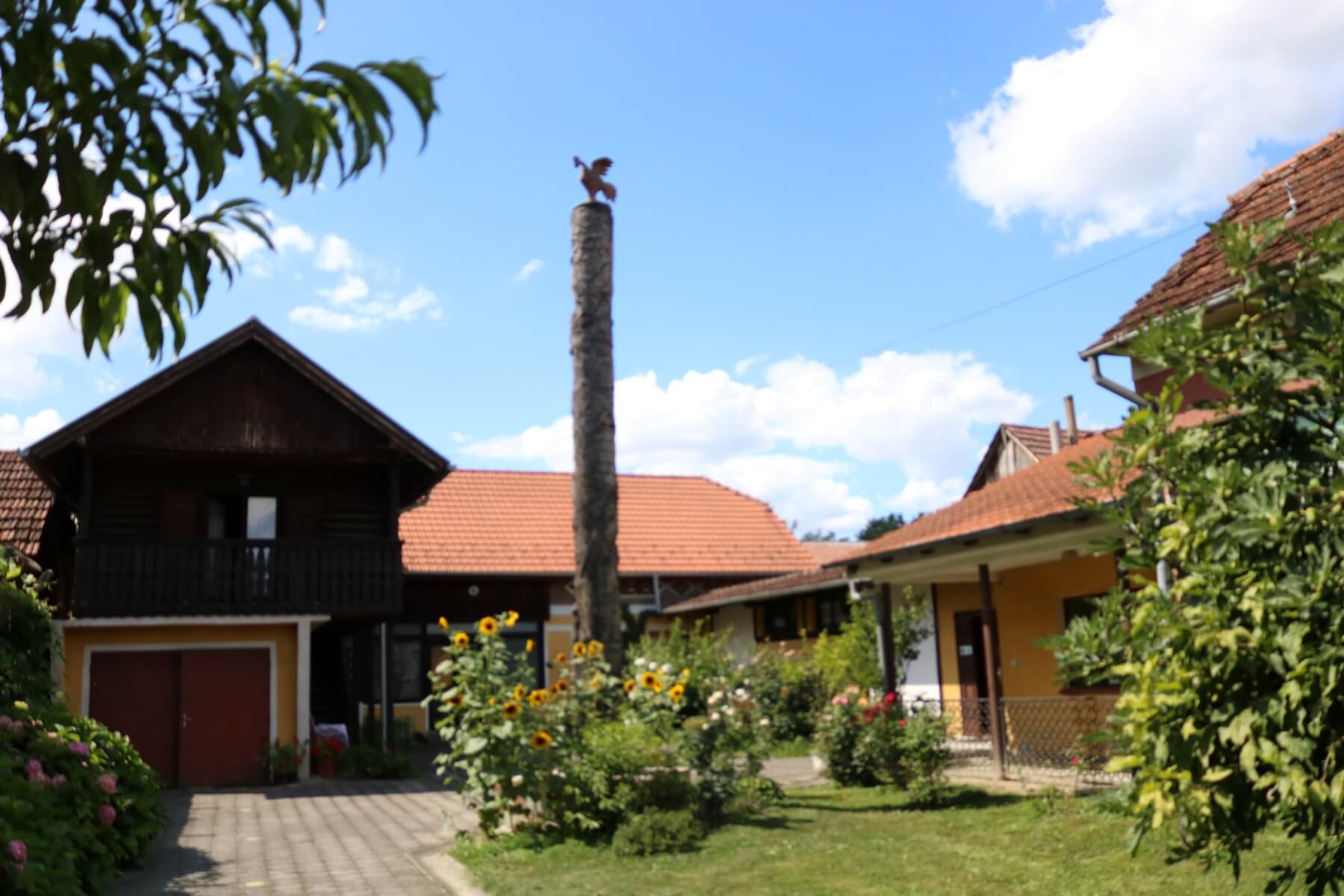
Some of the work by artists from the first and second generation of the Hlebine School are scattered far and wide. But, with the canon of Ivan Večenaj, it's a different story. Truly breathtaking examples of his finest work – definitely among the very best – were reserved by the artist for his family collection. Included in the collection, most of his key sacral works, including Golgotha, a triptych of the life of Jesus, crucifixion and the Four Horsemen of the Apocalypse. Don't worry, it's not all doom and gloom. Beautiful and bright images of Podravina roosters, agriculture and a charming portrait of his wife hang alongside. You can view them all at Večenaj's former home, now Galerija Ivan Večenaj in Gola. Across the road, an ethnic museum preserves life how it once was here. A truly unmissable highlight on the trail of Croatian Naive Art. Find out more about the gallery here.
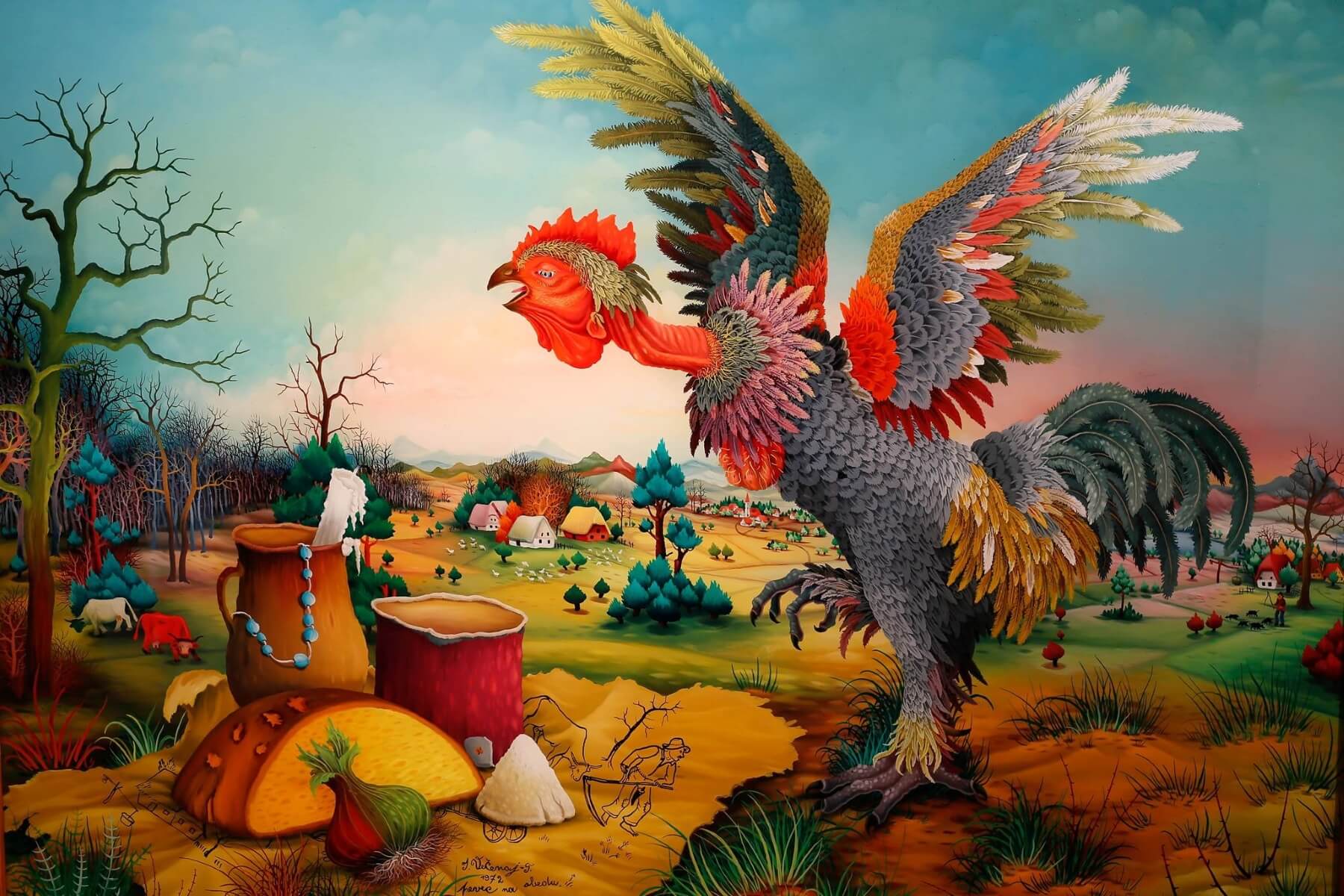 'Pevec na obedu' © Galerija Ivan Večenaj
'Pevec na obedu' © Galerija Ivan Večenaj
Galerija Ivan Lacković, Batinske
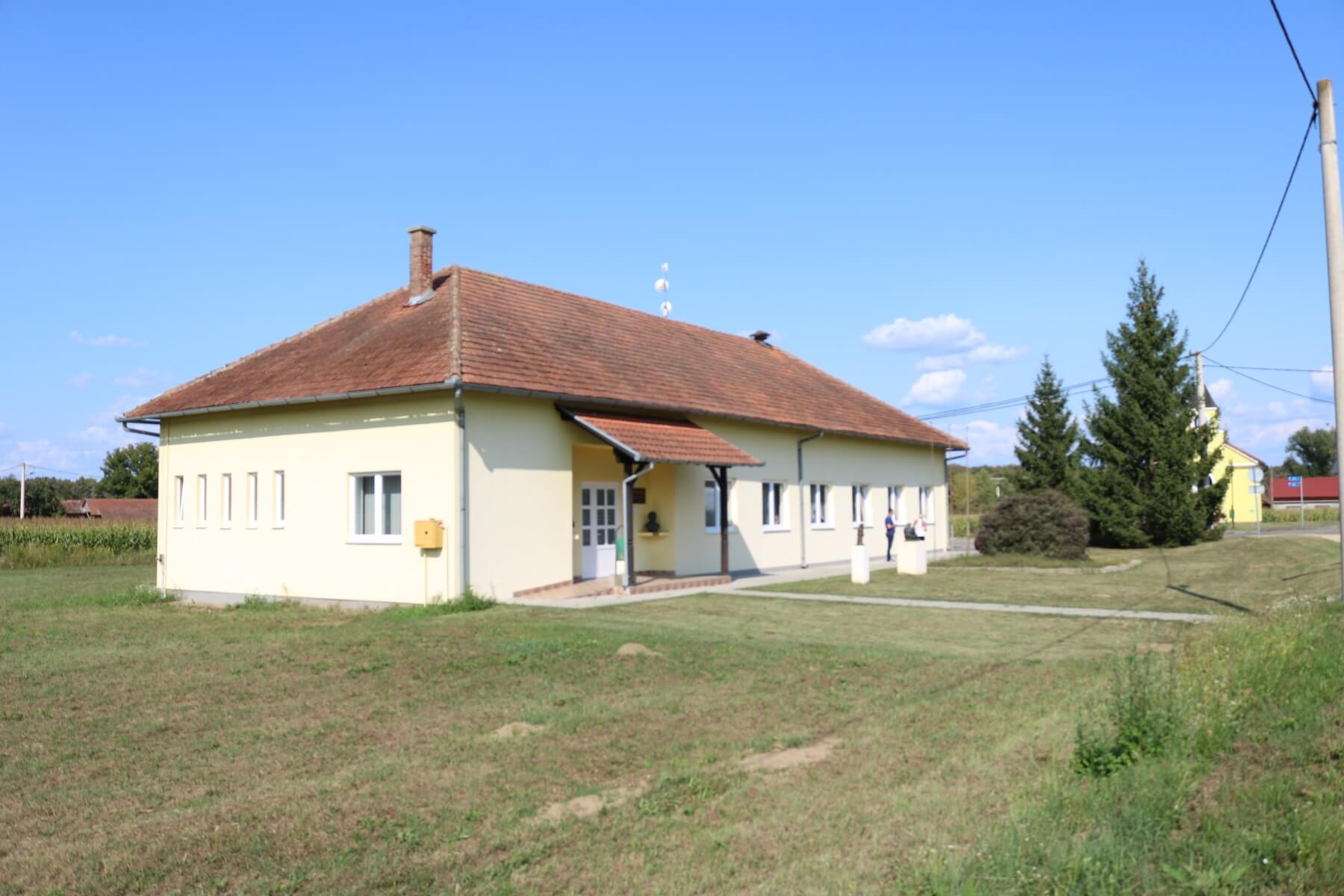
Clearly something of a local patriot, Ivan Lacković donated some 300 works to the village of his birth. Within the collection, you'll find not only works by Lacković himself but also sculptures by Naive Artists Ljubica Marulec and the painter's brother, M. Lacković. Find out more about the gallery here.
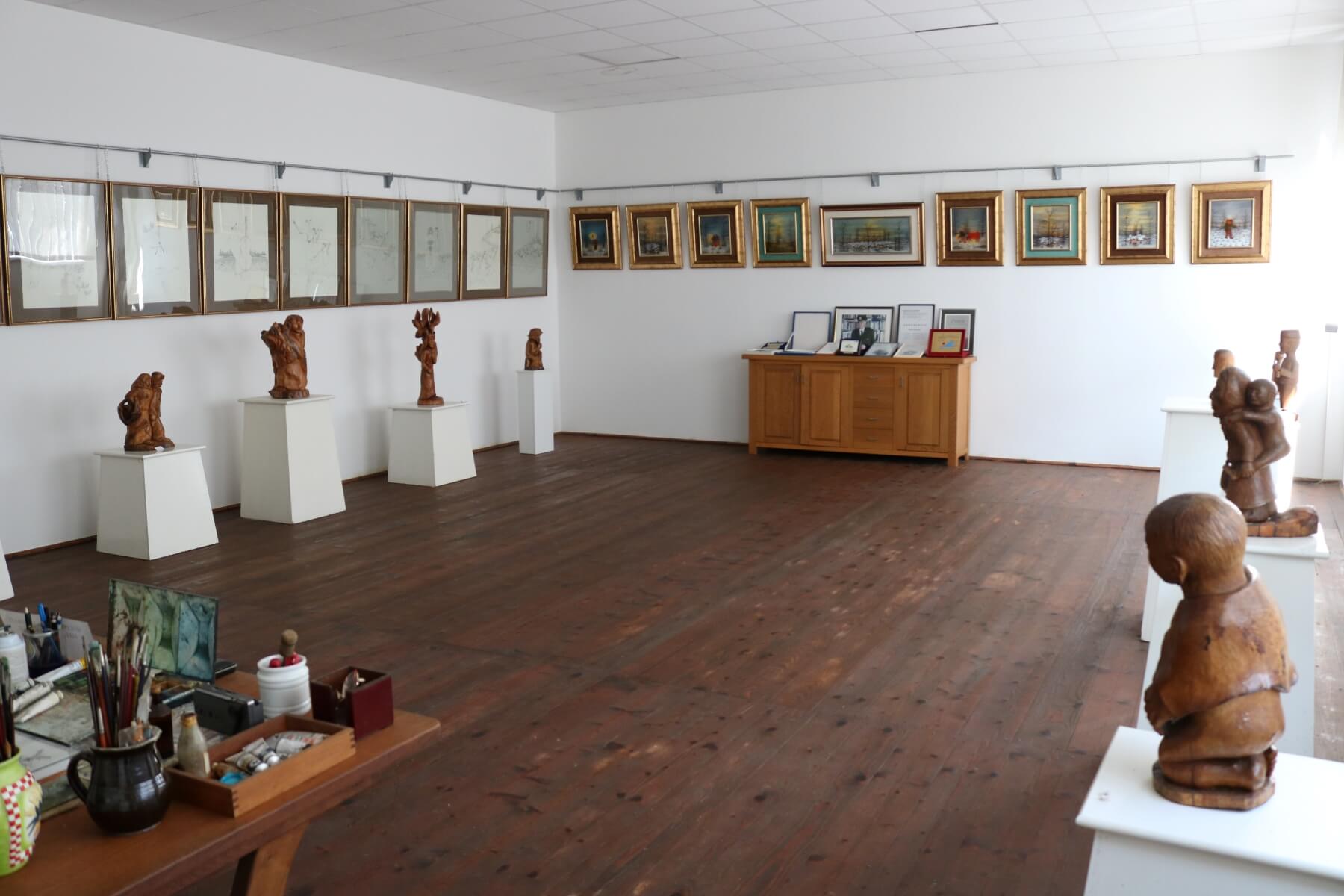
Podravina Motifs (Podravski motivi)
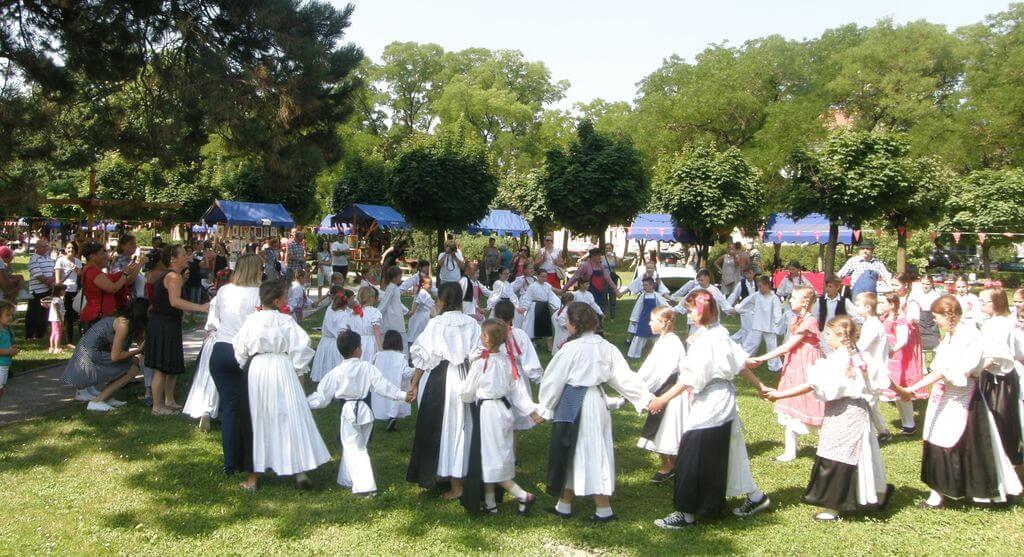 Podravina Motifs (Podravski motivi). Photo © Grad Koprivnica
Podravina Motifs (Podravski motivi). Photo © Grad Koprivnica
A three-decade-old Koprivnica event that showcases all of the cuisine, culture, music, dance, costume and art of Podravina. Naive Art is a key and central theme to the event. Usually, there are over 50 contemporary Naive Artists from the region exhibited, with their work on sale. Taking place each summer, it's a great place to get to know traditional Podravina and to pick up some amazing gifts. Find out more about the event here.
Šetnja kroz naivu u Hlebinama (Walk Through The Naive of Hlebine)
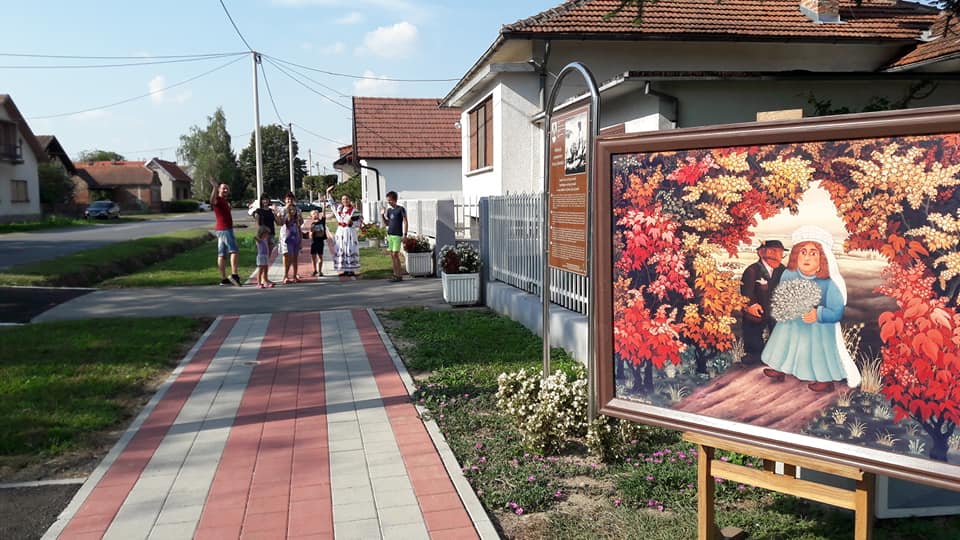 Outside Galerija Josip Generalić during Šetnja kroz naivu u Hlebinama © Tourist Board Central Podravina
Outside Galerija Josip Generalić during Šetnja kroz naivu u Hlebinama © Tourist Board Central Podravina
An annual open-air gallery of Hlebine Naive Art taking place on the streets of the village itself. Organised by Tihomir Želimorski who has the rural accommodation offer Stari zanati in Hlebine, Šetnja kroz naivu u Hlebinama differs from Podravina Motifs because it focusses exclusively on art – painting and sculpture. The houses in Hlebine are treasure troves of Croatian Naive Art. During this summertime event, all village residents bring their paintings and statues out onto the streets, hang them on trees or in gardens. You're invited to walk around the delightful village to look. Find out more about the event here.
This article was produced with the kind help of Koprivnica-Križevci County Tourist Board and checked for accuracy by Koprivnica Town Museum.
If you want to find out the latest from Podravina, be sure to check TCN pages here.


